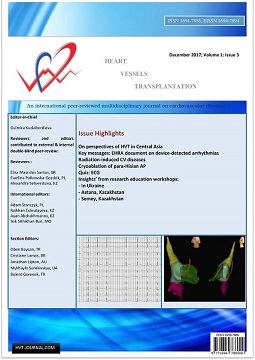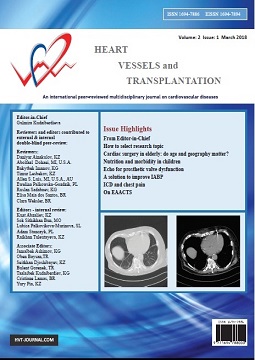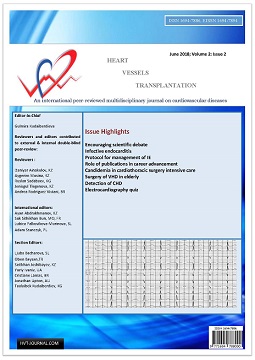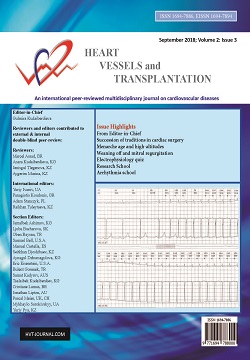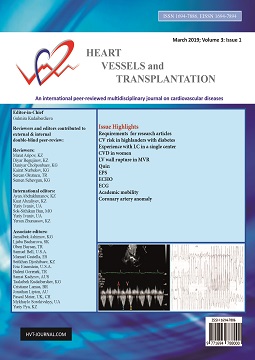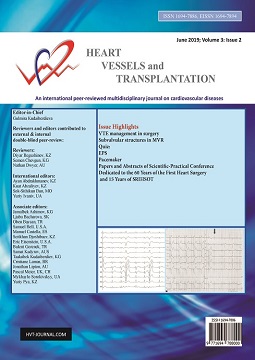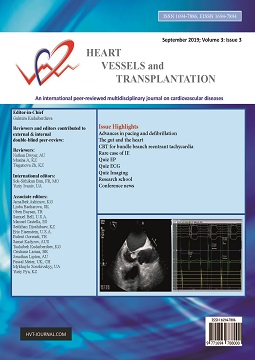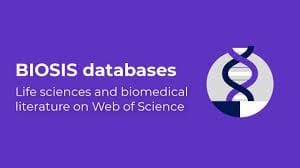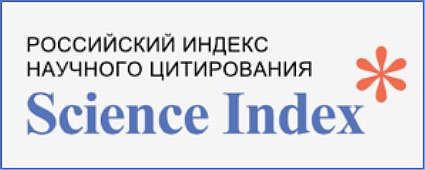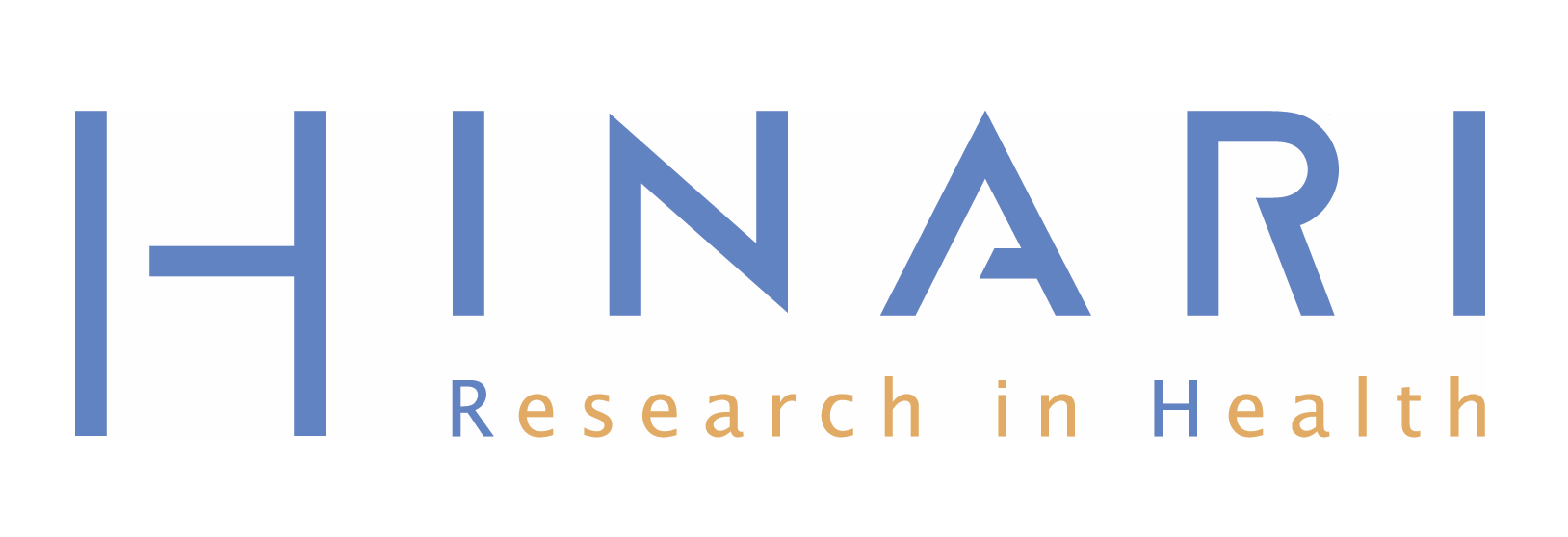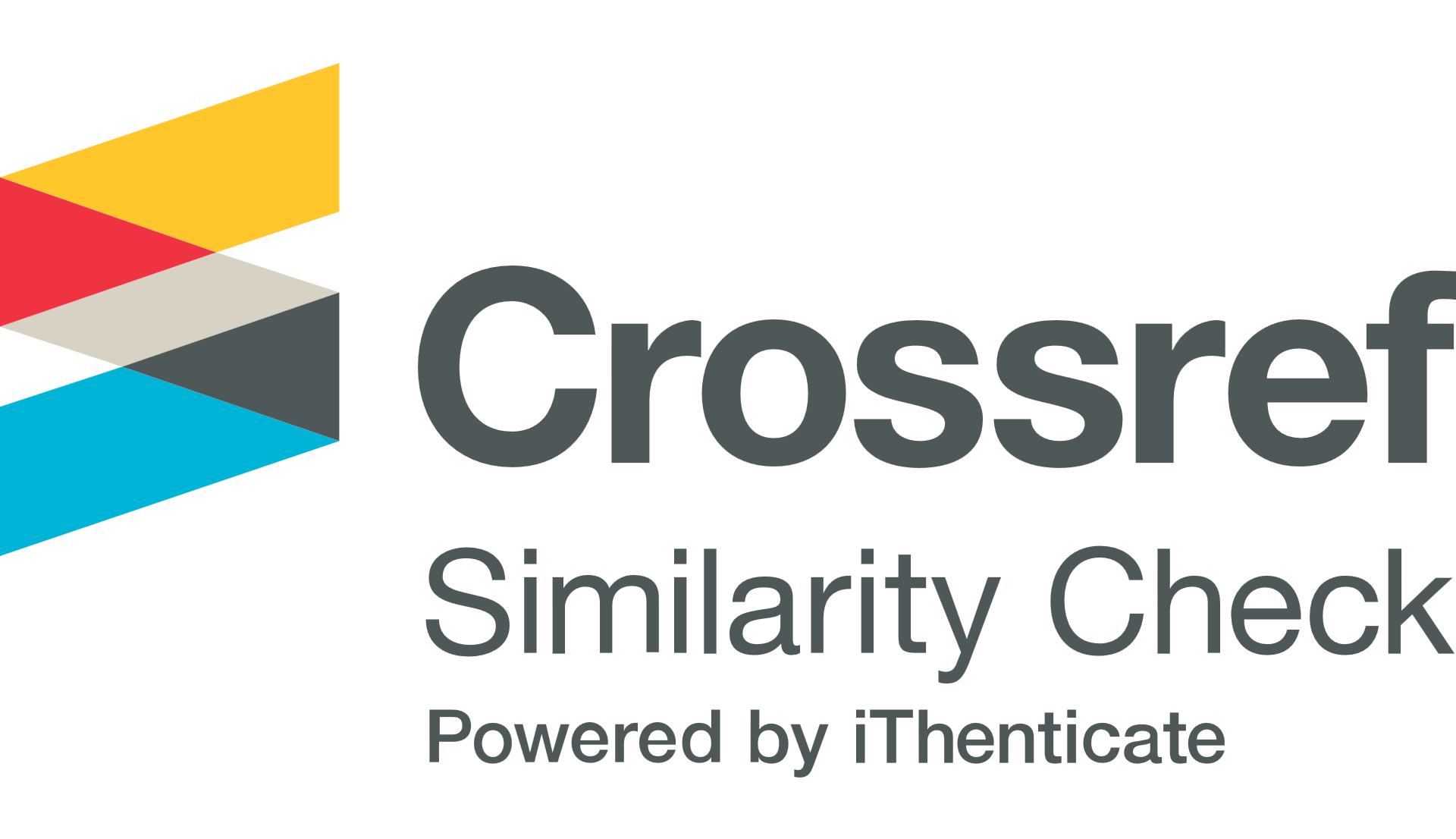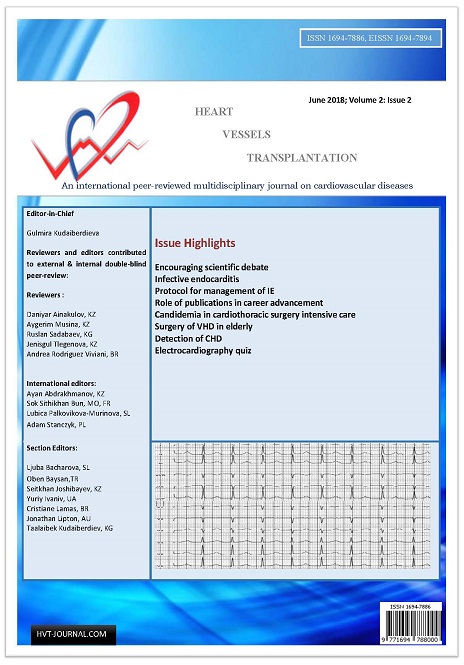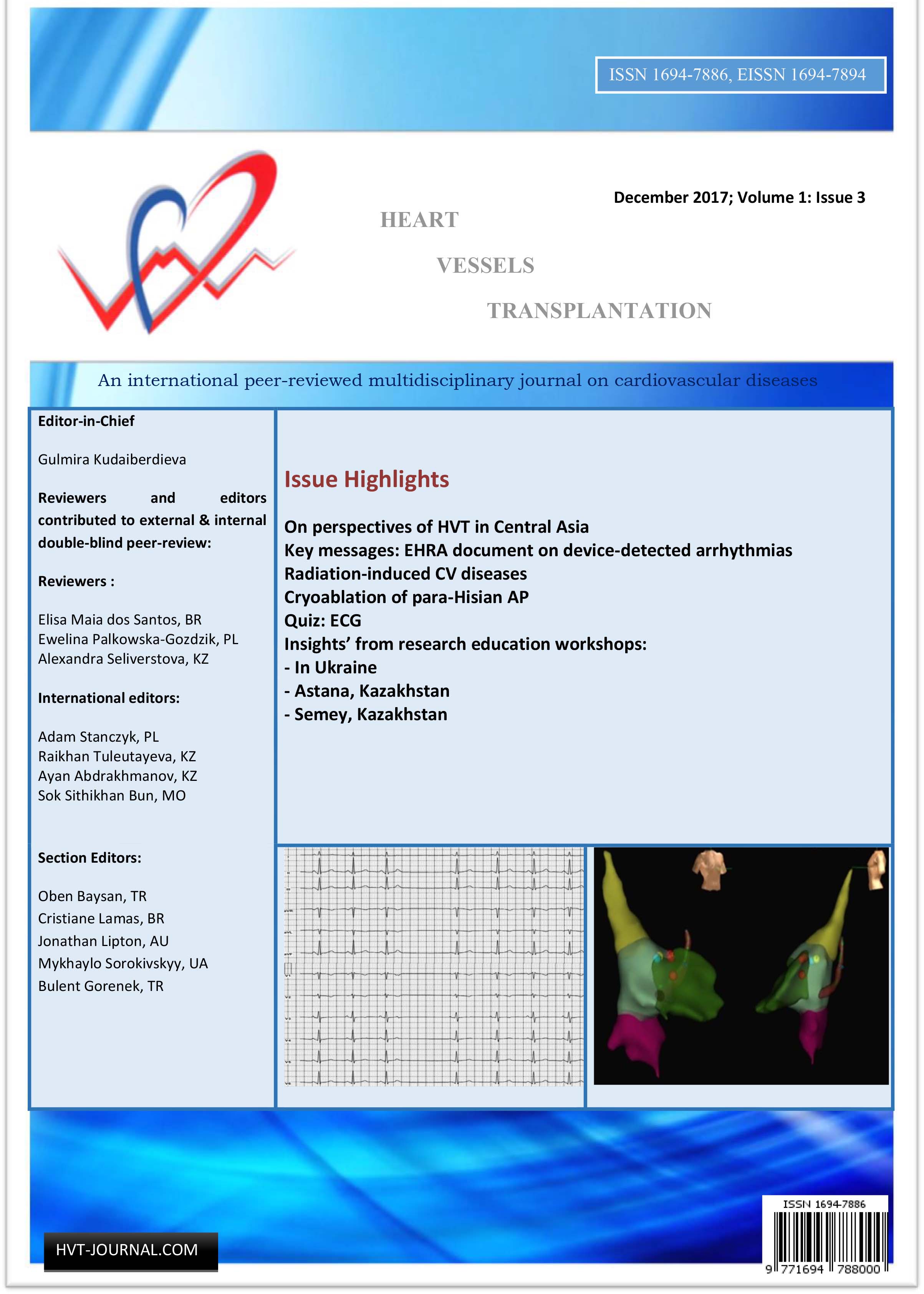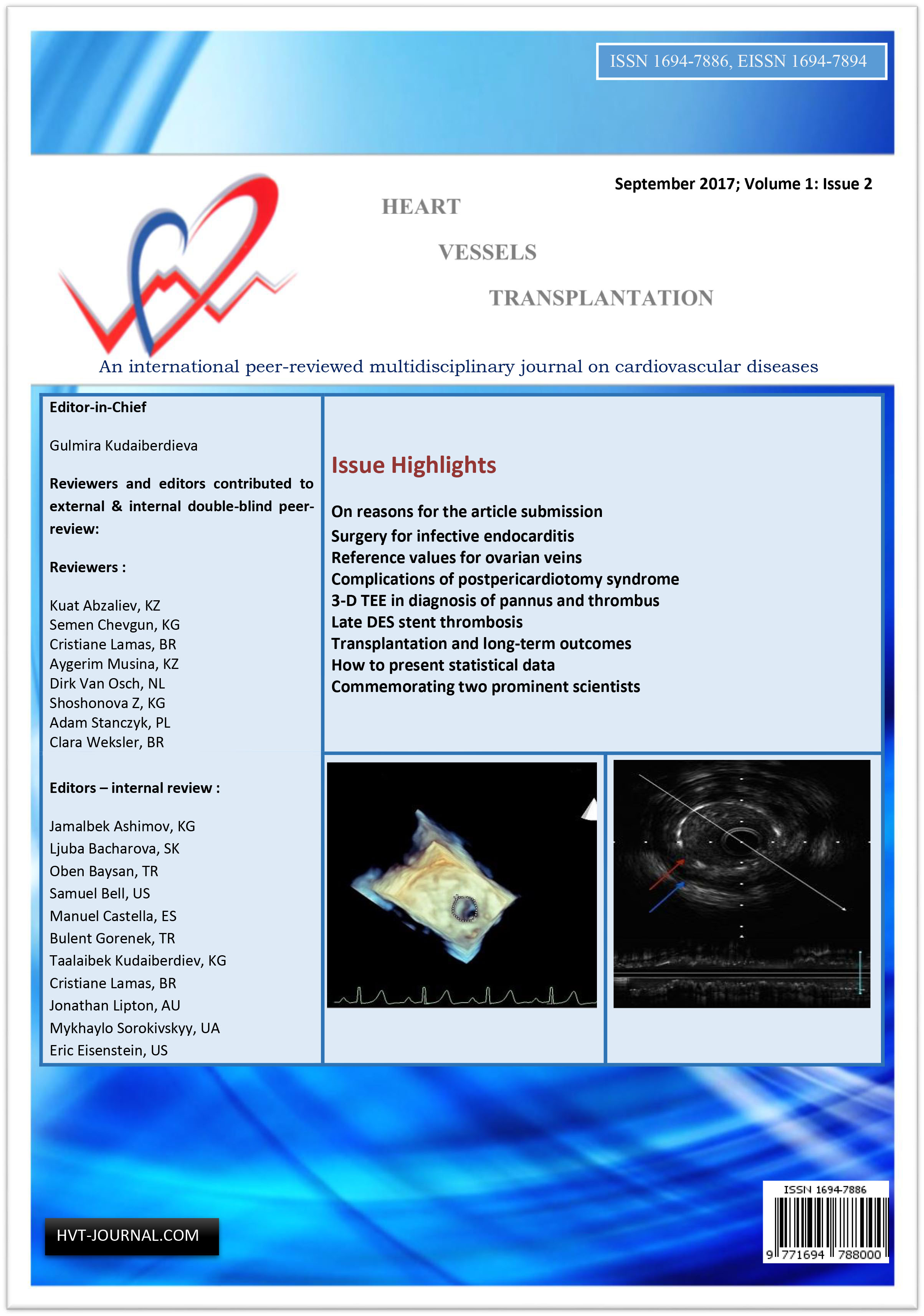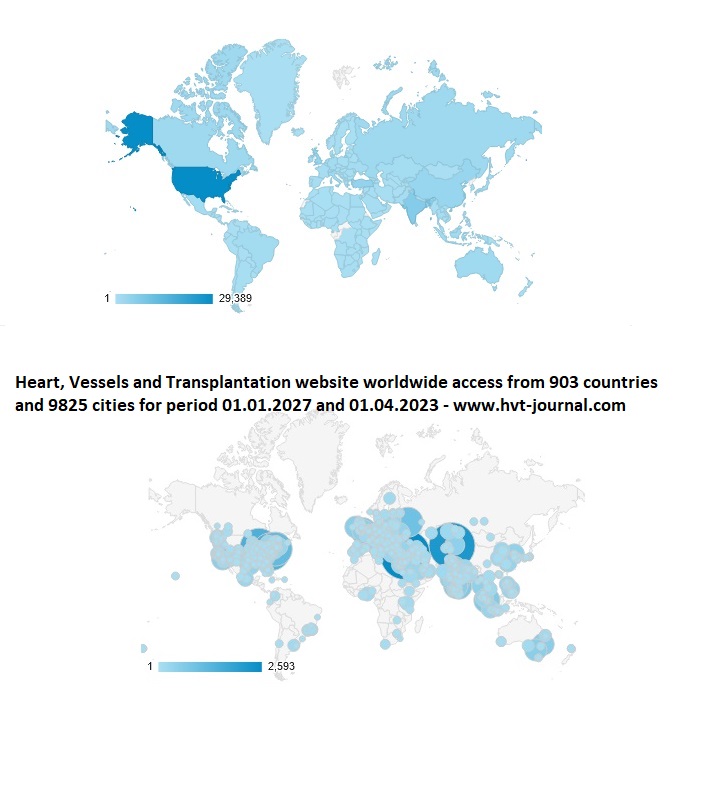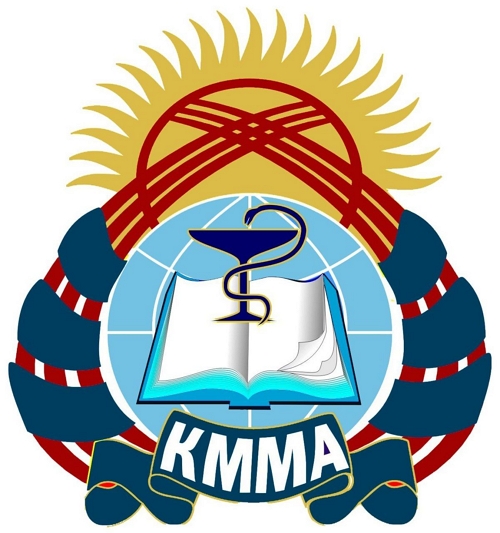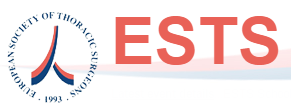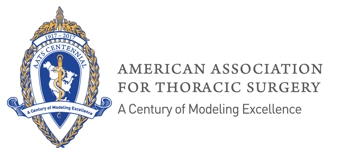
Upcoming discussions, debates
On sweet undeniable feeling of power of international intellectual feudalism, bias, discrimination, censoring and theft
- by Gulmira Kudaiberdieva, Editor-in-Chief Heart Vessels and Transplantation
Links to COVID - 19 resources
CURRENT ISSUE
Vol 8 ( 2024 ); Issue 3
EDITORIALS
From Editor-in-Chief: Our Hirsch index, current issue, news from ESC 2024, trials and new guidelines, protection and long COVID
- Gulmira Kudaiberdieva
- Published: 10/09/2024
- DOI: 10.24969/hvt.2024.510
EDITORIALS
Management of cardiogenic shock in older adults: A commentary on the 2024 American Heart Association Scientific Statement
- Chieh-en Hsu, Alberto Emanuele Fratta, Stefano Cacciatore
- Published: 06/07/2024
- DOI: 10.24969/hvt.2024.496
EDITORIALS
Stress echocardiography in daily clinical practice: an update from the European Association of Cardiovascular Imaging
- Francesco Loria, Giuseppe Luliano
- Published: 29/07/2024
- DOI: 10.24969/hvt.2024.500
EDITORIALS
Format for presenting a clinical case in the scientific journal
- Kuat B. Abzaliyev
- Published: 15/08/2024
- DOI: 10.24969/hvt.2024.503
EDITORIALS
Review of AHA scientific statement on pharmacological management of cardiac arrhythmias in the fetal and neonatal periods
- Yuriy Ivaniv, Natalia Lozynska
- Published: 05/08/2024
- DOI: 10.24969/hvt.2024.501
EDITORIALS
Contemporary strategies in the prevention, diagnosis, and management of cardiovascular implantable electronic device infections
- Elkin Gonzalez Villegas
- Published: 10/08/2024
- DOI: 10.24969/hvt.2024.502
EDITORIALS
An overview of critical care management of patients after cardiac arrest: A statement towards individualized, patient-centered care
- Gabriele Martelli, Alessandra Maggiolo, Ivo Tiberio
- Published: 22/08/2024
- DOI: 10.24969/hvt.2024.507
ORIGINAL RESEARCH ARTICLE
Assessment of knowledge, attitude and practice of biomedical waste management among nursing staff in a tertiary care teaching hospital
- N.Srisuja Reddy, M.Yamuna Rani, Shreenivas Shouri, Battula Anoosh Kalyan
- Published: 22/07/2024
- DOI: 10.24969/hvt.2024.498
ORIGINAL RESEARCH ARTICLE
A study on patients’ perception of signage system in a tertiary care teaching hospital
- Battula Anoosh Kalyan, M.Yamuna Rani, Shreenivas Shouri
- Published: 22/07/2024
- DOI: 10.24969/hvt.2024.499
ORIGINAL RESEARCH ARTICLE
Minimally-invasive valve surgery in patients with valvular heart disease with comorbidities: A single centre experience
- Milan Snehkunj, Ketav Lakhia, Ronak Khojani, Himani Pandya, Chirag Doshi
- Published: 30/06/2024
- DOI: 10.24969/hvt.2024.494
ORIGINAL RESEARCH ARTICLE
Predictors of postoperative atrial fibrillation after off-pump coronary artery bypass grafting – a prospective observational study
- Milan Snehkunj, Bahul Vekaria, Ketav Lakhia, Ishan Gohil, Jignesh Kothari
- Published: 17/07/2024
- DOI: 10.24969/hvt.2024.497
ORIGINAL RESEARCH ARTICLE
Diaphragmatic paralysis after pediatric cardiac surgery: Associated implications and outcomes
- Roberta da Silva Teixeira, Tatiana Paiva de Adauto, Katherine Almeida Kopke, Luana da Silva Lopes
- Published: 04/07/2024
- DOI: 10.24969/hvt.2024.495
ORIGINAL RESEARCH ARTICLE
Exploring precipitants of re-coarctation in coarctation of the aorta patients
- Bobur B. Turaev, Khakimjon K. Abralov, Nodir Sh. Ibragimov
- Published: 22/08/2024
- DOI: 10.24969/hvt.2024.505
REVIEW
Chronic coronary syndromes: diagnosis, management and gaps in evidence
- Dario Mafrica, Giuseppe Franculli, Antonio Esposito, Gianmarco Sarto, Pierre Sabouret, Giuseppe Biondi-Zoccai , Marco Bernardi
- Published: 28/08/2024
- DOI: 10.24969/hvt.2024.508
CASE REPORT
Single-chamber permanent pacemaker implantation in patient with persistent left superior vena cava anomaly: a case report
- Oleh Semeniuk, Oleksiy Myshakivskyy, Mykhaylo S. Sorokivskyy, Ulyana P. Chernyaha-Royko
- Published: 20/06/2024
- DOI: 10.24969/hvt.2024.493
CASE REPORT
Amyotrophic lateral sclerosis in a combination with frontotemporal dementia: A clinical case study
- Nurzhan T. Dzhaparalieva, Eldana B. Bolotbekova, Begimai B. Kadyrova, Irina A. Sverdlova, Asel T. Jusupova
- Published: 20/08/2024
- DOI: 10.24969/hvt.2024.504
EDUCATION
The IRIS 2024 (Bratislava, Slovakia) again in-person format
- Marta Kollarova, Kristian Guzma, Allan Bohm, Ljuba Bacharova
- Published: 22/08/2024
- DOI: 10.24969/hvt.2024.506
Articles Published Ahead of Print
DEBATES
On sweet undeniable feeling of power of international intellectual feudalism, bias, discrimination, censoring, theft, and yet cloud of rumors again – Part 1
This is a first piece we open for debate and discussion. As every editor can comprehend from the title of this short introduction, this is about may be some journal editors have experienced or it may only be intrinsic for our journal.
- Gulmira Kudaiberdieva
- Published: 20/12/2017
- DOI: 10.24969/hvt.2017.35
ANNOUNCEMENT
Announcement on peer-review during COVID-19 pandemics
This is to notify that we prolong the time for review and revision for manuscripts we receive for consideration for publication for authors, reviewers and editors involved in the fight against COVID -19.
- Published: 03/06/2020
ANNOUNCEMENT
Academic English writing course October 2022
The Heart, Vessels and Transplantation journal, Center for Scientific Research and Development of Education, Bishkek, Kyrgyzstan and British Council office invite you to take part in online Academic English Writing Course that starts on January 2023 (Every Monday and Wednesday 5-6 pm Bishkek time ).
- Published: 15/12/2020
ANNOUNCEMENT
Announcement on Echocardiography Course - CSR&DE
Center for Scientific Research and Development of Education organizes course online echocardiography for beginners for physicians, residents and interns. The course starts in October 29, 2024, 2 times per week
- Published: 17/09/2021
ANNOUNCEMENT
Announcement on Biomedical Statistics Course - CSR&DE
Center for Scientific Research and Development of Education organizes online course on biomedical statistics that will help you understand and use statistics for your scientific work, thesis and dissertations and manuscripts. The course starts on April , 2023, 8-9.30 pm Bishkek, Kyrgyzstan time, every Tuesday and Thursday for 5 weeks.
- Published: 17/09/2021
ANNOUNCEMENT
INTERNATIONAL RESEARCH INTERDISCIPLINARY SCHOOL – IRIS 2022
International Research School organized by Heart, Vessrls and Transplantation journal and CSRDE will be held in November 2022 online, semi-virtual format is also on agenda if global pandemics sitiation will allow to make semi-virtual. We invite young researchers, residents, PhD students and junior faculty members of universities, research institutons, teaching hospitals who would like to acquire research skills in preparation of scientific project.
- Published: 20/01/2022
ORIGINAL RESEARCH ARTICLE
Association of diastolic and renal dysfunctions in non-ST segment elevation acute coronary syndrome patients with heart failure with preserved ejection fraction and their impact on outcomes
- Kanybek Kaliev, Medet T. Beishenkulov, Aiperi Toktosunova, Amantur Kolbai
- Published: 08/09/2024
- DOI: 10.24969/hvt.2024.509
ORIGINAL RESEARCH ARTICLE
Predictive capability of PUMA score in detection of chronic obstructive pulmonary disease
- Ramya Gadam, Athili Suryakanth, M.Yamuna Rani, Guttula Narayana Ravi Sai Dattu, V. Surya Kumari
- Published: 15/09/2024
- DOI: 10.24969/hvt.2024.513
ORIGINAL RESEARCH ARTICLE
Diagnostic accuracy of neutrophil-to-albumin ratio in predicting aortic valve sclerosis: A retrospective study
- Ahmet Kivrak, Murat Akdogan, Cagatay Tunca, Veysel Ozan Tanik, Kamuran Kalkan, Funda Basyigit
- Published: 19/09/2024
- DOI: 10.24969/hvt.2024.514
ORIGINAL RESEARCH ARTICLE
Experience of treatment of newborns with gastroschisis in the conditions of the national center for maternal and child health care
- Tatyana A. Akmentieva, Kamchibek A. Uzakbaev, Natalia F. Gagloeva
- Published: 24/09/2024
- DOI: 10.24969/hvt.2024.515
ORIGINAL RESEARCH ARTICLE
Catheter-related right atrial thrombosis: a case series
- Juan Francisco Rodríguez Alvarado, Raul Cruz Palomera, Eduardo Sánchez Cortés, Jorge Guillermo Arenas Fonseca, José Darío Valencia González
- Published: 28/09/2024
- DOI: 10.24969/hvt.2024.516
CASE REPORT
Bentall De Bono surgery using a composite graft containing a biological prosthesis of the aortic valve under artificial circulation: A clinical case study
- B.K. Kadyraliev, V.B. Arutyunyan, A.A. Alexandrov, Jamal I. Ashimov, A.B. Zhumanazarov, Zhanybek J. Gaibyldaev, Ruslan A. Sadabaev, Zhakshylyk Abdimitalip Uulu, A.T. Satybaldiev, T.J. Duishoev, A. Kurmanbekova
- Published: 02/10/2024
- DOI: 10.24969/hvt.2024.517
CASE REPORT
Massive pericardial effusion as a manifestation of cardiac angiosarcoma
- Ihor Romaniuk, Andriy Mangov, Sofia Vyshynska, Oleh Kobziev, Uliana Pidvalna
- Published: 02/10/2024
- DOI: 10.24969/hvt.2024.518
ORIGINAL RESEARCH ARTICLE
Transcatheter versus surgical aortic valve replacement: a meta-analysis of comparative outcomes in low- and intermediate-risk patients with severe aortic stenosis
- Saif Almuzainy, Omar Sameer Hamodat, Salma Nizar
- Published: 06/10/2024
- DOI: 10.24969/hvt.2024.519
CASE REPORT
Hybrid treatment of a saccular aneurysm of the aortic arch - long term follow-up: A case report
- Fabio Massimo Oddi, Grazia Granata , Mauro Fresilli, Martina Battistini, Andrea Ascoli Marchetti, Arnaldo Ippoliti
- Published: 11/10/2024
- DOI: 10.24969/hvt.2024.520
CASE REPORT
Severe, rapidly evolving infective endocarditis as a complication of elective surgery: a case report
- Roxana F. Mamani, Ezequias B. Martins, Paulo A.D. ` Mendonca, Rivelino T. Azevedo, Diego A. Fraca, Julian C.A. Diaz, Nathalia F. Konig, Victor C.M. Fernandes, Cristiane Lamas
- Published: 15/10/2024
- DOI: 10.24969/hvt.2024.521
Vol 8 ( 2024 ); Issue 2
EDITORIALS
From Editor-in-Chief: One firm step forward, our June 2024 issue, meetings and evidence updates, COVID aftermath and welcome to new Editors
- Gulmira Kudaiberdieva
- Published: 14/06/2024
- DOI: 10.24969/hvt.2024.492
- Page(s): 165-168
EDITORIALS
Lipid management: Insights from NICE clinical guidelines 2023
- Khalil Ahmad Ahrari
- Published: 08/04/2024
- DOI: 10.24969/hvt.2024.476
- Page(s): 169-172
EDITORIALS
New atrial fibrillation guidelines: a cool breeze has arrived
- Luis Antonio Arabia
- Published: 20/03/2024
- DOI: 10.24969/hvt.2024.474
- Page(s): 173-174
EDITORIALS
The 24th organ: the aorta. The main concept of new EACTS/STS Guidelines
- Fabio Massimo Oddi, Grazia Granata , Leonardo Oddi, Giorgio Fedeli, Vincenzo Brizzi
- Published: 21/04/2024
- DOI: 10.24969/hvt.2024.481
- Page(s): 175-177
ORIGINAL RESEARCH ARTICLE
Remodeling of the microcirculation of the small intestine with a fatty diet in rats: an experimental randomized study
- Bolotbek Alymzhan uulu, Elmira M. Mamytova, Yusuf Kh-M. Shidakov, Aycholpon T. Israilova, Aina Dj. Mamytova, Rustam R. Tukhvatshin, Tamara S. Abaeva, Nurbek K. Monolov, Amanbek M. Mamytov
- Published: 09/05/2024
- DOI: 10.24969/hvt.2024.483
- Page(s): 178-190
ORIGINAL RESEARCH ARTICLE
Ejection fraction improvement in left ventricular-only pacing vs. BiVentricular pacing in patients with heart failure
- Randa Tabbah, Jamil Francis, Hadi Skouri, Maurice Khoury, Bernard Abi-Saleh
- Published: 27/02/2024
- DOI: 10.24969/hvt.2024.465
- Page(s): 191-199
ORIGINAL RESEARCH ARTICLE
Ablation outcomes and quality of life in patients with atrial flutter and concomitant paroxysmal atrial fibrillation
- Anastasia Aker, Ulyana P. Chernyaha-Royko, Mykhaylo S. Sorokivskyy, Borys Kravchuk
- Published: 20/03/2024
- DOI: 10.24969/hvt.2024.473
- Page(s): 200-207
ORIGINAL RESEARCH ARTICLE
Comparison of the clinical profile and outcomes of Covid-19 infection in vaccinated and unvaccinated people
- Sridevi Ganesan, Ramya Gadam, V. Surya Kumari
- Published: 15/04/2024
- DOI: 10.24969/hvt.2024.478
- Page(s): 208-212
ORIGINAL RESEARCH ARTICLE
Analysis of food poisoning for the period from 2013 to 2023 in Bishkek, Kyrgyz Republic
- Dilbar J. Bekieva, Marina K. Esenamanova, Feruza A. Kochkorova, Tatyana Tsivinskaya, Raisa M. Atambaeva, Rakhimahon G. Gainazarova, Aliman M. Umuralieva, Gulnar K. Sibagatova, Svetlana K. Kenzhegaliyeva, Aizhanat Daniyarova
- Published: 26/05/2024
- DOI: 10.24969/hvt.2024.485
- Page(s): 213-220
ORIGINAL RESEARCH ARTICLE
Influence of time in therapeutic range on postoperative complications in mechanical heart valve replacement patients operated with the indigenous TTK Chitra heart valve
- Tarun Shetty, Hemachandren M, Ram Sankar P, Durga Prasad R
- Published: 28/04/2024
- DOI: 10.24969/hvt.2024.482
- Page(s): 221-230
ORIGINAL RESEARCH ARTICLE
Early and mid-term outcome of inhaled versus intravenous milrinone in patients with rheumatic mitral stenosis and pulmonary hypertension undergoing mitral valve surgery
- Jigar Patel, Pankaj Garg, Ashish Madkaiker, Ketav Lakhia, Kartik Patel
- Published: 19/05/2024
- DOI: 10.24969/hvt.2024.484
- Page(s): 231-243
ORIGINAL RESEARCH ARTICLE
COVID-19 sequelae on transthoracic echocardiography findings in pediatric patients with septal congenital heart disease: A retrospective comparative analysis
- Damirbek A. Abibillaev, Elmira N. Tukusheva, Akmaral Kurmanbekova, Begaiym Ulugbekova, Raushan Barakanova, Taalaibek Z. Kudaiberdiev, Zhumagul Tashbolot kyzy, Kubra Abdulbakioglu, Azizakan Rakhmanova, Aidina Kazymbek, Kudaibergen Osmonaliev
- Published: 31/05/2024
- DOI: 10.24969/hvt.2024.486
- Page(s): 244-251
ORIGINAL RESEARCH ARTICLE
Effects of the cardiac rehabilitation program on the quality of life in patients after open-heart surgery
- Moldir Baibolova, Berik A. Bolatbekov, Kymbat Trusheva, Kuramys S. Kuramysuly, Zarina S. Bolatbekova, Berikbay Yesenbekov
- Published: 16/04/2024
- DOI: 10.24969/hvt.2024.479
- Page(s): 252-262
ORIGINAL RESEARCH ARTICLE
Clinical and neuroimaging predictors of early hospital mortality in patients with hemorrhagic stroke
- Dariha I. Bakaeva, Elmira M. Mamytova, Mitalip M. Mamytov, Khalida S. Musaeva, Damirbek A. Abibillaev, Nurbek K. Monolov
- Published: 11/06/2024
- DOI: 10.24969/hvt.2024.488
- Page(s): 263-276
BRIEF REPORT
Are we the “Catalyst” to accomplish pragmatic solutions against challenges in Pakistani Healthcare?
- Fouad A. Khokhar, Farah T. Tabassam, Irfan A. Ahmad, Maqsood M. Elahi
- Published: 12/06/2024
- DOI: 10.24969/hvt.2024.491
- Page(s): 277-283
SYSTEMATIC REVIEW
Hospital predictors of deep vein thrombosis after ischemic stroke: A systematic review
- Karlygach T. Torokulova, Gulmira S. Biyalieva, Elena N. Akulich, Elmira M. Mamytova, Aina J. Mamytova, Leila R. Akhmadeeva
- Published: 06/02/2024
- DOI: 10.24969/hvt.2024.459
- Page(s): 284-292
REVIEW
Etiopathogenesis, diagnosis and treatment strategies for stroke-associated pneumonia
- Turat S. Kadyrov, Elmira M. Mamytova, Ayna Dj. Mamytova, Anara U. Toktomametova, Мaksatbek A. Batyrov, Nurzhan T. Dzhaparalieva
- Published: 08/04/2024
- DOI: 10.24969/hvt.2024.477
- Page(s): 293-301
SYSTEMATIC REVIEW
Cardiotoxicity of checkpoint inhibitors: focus on immune side effects
- Yuri I. Buziashvili, Elmira U. Asymbekova, Elvina F. Tugeeva, Elena V. Artamonova, Firdavsdzhon R. Akildzhonov
- Published: 21/04/2024
- DOI: 10.24969/hvt.2024.480
- Page(s): 302-312
CASE REPORT
Ischemic stroke from non-bacterial thrombotic endocarditis embolization in Li-Fraumeni syndrome: A case report
- Silvia Andaloro, Stefano Cacciatore, Maria Anna Nicolazzi, Federico Biscetti, Clarissa Modafferi, Emanuela Lucci-Cordisco, Antonio Gasbarrini, Andrea Flex
- Published: 03/06/2024
- DOI: 10.24969/hvt.2024.487
- Page(s): 313-318
Vol 8 ( 2024 ); Issue 1
EDITORIALS
From Editor-in-Chief: On current issue, journal`s performance in 2023, acknowledging best, authors` and reviewers` feedback on peer-review and content, insights on the latest trials and guidelines, and changes in COVID policies
- Gulmira Kudaiberdieva
- Published: 11/03/2024
- DOI: 10.24969/hvt.2024.469
EDITORIALS
The role of revascularization in chronic coronary disease: a reappraisal stemming from the most recent AHA/ACC/ACCP/ASPC/NLA/PCNA guidelines
- Marco Borgi, Giuseppe Biondi Zoccai, Francesco Versaci
- Published: 06/01/2024
- DOI: 10.24969/hvt.2024.453
EDITORIALS
Infective endocarditis: comments on the 2023 Duke-International Society for Cardiovascular Infectious Diseases Criteria for Infective Endocarditis: Updating the Modified Duke Criteria
- Cristiane C. Lamas
- Published: 11/02/2024
- DOI: 10.24969/hvt.2024.460
EDITORIALS
Expert opinion on conduction system pacing implantation: A new approach to cardiac pacing
- Narendra Kumar
- Published: 04/03/2024
- DOI: 10.24969/hvt.2024.466
EDITORIALS
Healthy aging and cardiovascular health in Kyrgyzstan: current status and emerging challenges
- Stefano Cacciatore, Luigi Spadafora, Silvia Andaloro, Alessandra Piscitelli, Marco Bernardi
- Published: 20/02/2024
- DOI: 10.24969/hvt.2024.462
EDITORIALS
CardiacEye foundation humanitarian medical camp for the welfare of local population in Kallar Kahar region
- Fouad A. Khokhar, Maqsood M. Elahi
- Published: 23/12/2023
- DOI: 10.24969/hvt.2023.450
ORIGINAL RESEARCH ARTICLE
Clinical and ultrasound features of Mondor's disease of the breast: a case series
- Aliya Kadyrova, Aziza Abdullaeva, Nurgasibat Musaeva, Kamilla Kozhanova, Aidana Medik Kyzy, Nurjan Sapharbek Kyzy
- Published: 22/10/2023
- DOI: 10.24969/hvt.2023.428
ORIGINAL RESEARCH ARTICLE
Clinical manifestations and treatment outcomes of pulmonary aspergilloma
- Popuri Madan, Kiran Ganta, Amulya Cherukumudi
- Published: 03/11/2023
- DOI: 10.24969/hvt.2023.432
ORIGINAL RESEARCH ARTICLE
A retrospective observational study of risk factors, angiographic patterns, short-term mortality and their correlations between on- pump and off- pump coronary artery bypass surgery
- C. Prabhakar Reddy, C. Sayee Sankar Vinod
- Published: 25/11/2023
- DOI: 10.24969/hvt.2017.437
ORIGINAL RESEARCH ARTICLE
Comprehensive assessment of the quality of life in patients with breast cancer during neoadjuvant chemotherapy
- Yuri I. Buziashvili, Ivan S. Stilidi, Elmira U. Asymbekova, Simon T. Matskeplishvili, Elvina F. Tugeeva, Nazli K. Akhmedyarova, Elena V. Artamonova, Firdavsdzhon R. Akildzhonov
- Published: 06/01/2024
- DOI: 10.24969/hvt.2024.452
ORIGINAL RESEARCH ARTICLE
Procalcitonin as a predictor of survival in patients with sepsis: A study on diagnostic accuracy
- Abhishek Verma, Karan Kaushik, Amit Taluja, Pratik Shah
- Published: 17/01/2024
- DOI: 10.24969/hvt.2024.454
ORIGINAL RESEARCH ARTICLE
Dynamics of the development of the epidemic of coronavirus infection and assessment of population immunity to SARS-COV-2 in the territory of the Kyrgyz Republic
- Zhanylai N. Nuridinova, Zuridin Sh. Nurmatov, Tatyana E. Kuchuk, Kaliya K. Kasymbekova
- Published: 21/01/2024
- DOI: 10.24969/hvt.2024.455
ORIGINAL RESEARCH ARTICLE
Deep venous thrombosis and pulmonary thromboembolism among COVID-19 patients
- Mitra Samareh Fekri, Faranak Salajegheh, Mohammad Rezaei Zadeh Ruker, Mohsen Nakhaie, Seyedeh Mahdieh Khoshnazar, Mohammad S. Shahmoradzadeh Miri, Hanieh Mirkamali
- Published: 20/02/2024
- DOI: 10.24969/hvt.2024.463
ORIGINAL RESEARCH ARTICLE
Predictors of early hospital mortality in patients with ischemic stroke
- Khalida S. Musaeva, Nurbek K. Monolov, Elmira M. Mamytova, Barikha I. Dakaeva, Damirbek A. Abibillaev
- Published: 27/02/2024
- DOI: 10.24969/hvt.2024.464
BRIEF REPORT
Evaluation of myocardial contraction fraction in transcatheter aortic valve replacement
- Luana da Graça Machado, Angelo Salgado, Andrea Rocha de Lorenzo
- Published: 23/12/2023
- DOI: 10.24969/hvt.2023.449
SYSTEMATIC REVIEW
Impact of inspiratory muscle training on respiratory muscle function and functional capacity in patients with heart failure: a systematic review
- Úrsula Pinelo Cavegn, Luiz Fernando Rodrigues Junior
- Published: 03/01/2024
- DOI: 10.24969/hvt.2024.451
CASE REPORT
A safe single stage strategy for surgical repair of redo coarctation of aorta with coronary artery bypass grafting in adults: A case report
- Thakut Gowtham, Utkarsh Sanghavi, Ishan Gohil, Devvrat Desai, Jignesh Kothari
- Published: 03/11/2023
- DOI: 10.24969/hvt.2023.431
CASE REPORT
Simultaneous surgery in combination of double myxoma of the right atrium and coronary heart disease
- Khamidulla Abdumajidov, Abrol A. Mansurov, Sh. T. Urakov
- Published: 09/11/2023
- DOI: 10.24969/hvt.2023.433
CASE REPORT
Design and implementation of cardiac rehabilitation in pediatric heart re-transplantation: a case report
- Roberta da Silva Teixeira, Fellipe Allevato Martins da Silva
- Published: 30/11/2023
- DOI: 10.24969/hvt.2023.438
EDITORIALS
Comment on “Design and Implementation of Cardiac Rehabilitation in Pediatric Heart Retransplantation: A Case Report”
- Vitaliy Petrov
- Published: 20/11/2023
- DOI: 10.24969/hvt.2023.436
CASE REPORT
Left ventricular perforation by a chest tube: Case report and review of complications
- Ulises Rojel-Martinez, Pablo Andres Reatiga-Vega, Flor Mayranny Marquez-Maldonado, Alan Cordova-Fierro, Karla Bozada-Nolasco
- Published: 25/01/2024
- DOI: 10.24969/hvt.2024.456
QUIZ
Quiz: A round cyst-like structure in the right atrium
- Yuriy Ivaniv, Natalia Lozynska
- Published: 03/02/2024
- DOI: 10.24969/hvt.2024.457
CASE REPORT
AQP4-IgG-seropositive neuromyelitis optica spectrum disorder concurring with anti-N-methyl-D-aspartate receptor encephalitis at pediatric age: a case report
- Nurzhan T. Dzhaparalieva, Asel T. Jusupova, Begimai B. Kadyrova, Yulia A. Solodovnikova, Zarema A. Kadyrova, Kubat Ibraimov
- Published: 14/03/2024
- DOI: 10.24969/hvt.2024.472
QUIZ
Answer to quiz: A round cyst-like structure in the right atrium
- Yuriy Ivaniv, Natalia Lozynska
- Published: 03/02/2024
- DOI: 10.24969/hvt.2024.458
QUIZ
Cardiac microanatomy: understanding fundamental histological features and functional significance in the heart
- Uliana Pidvalna, Tetiana Harapko, Ihor Kharkalis, Maria Podoliuk, Lesya Mateshuk-Vatseba
- Published: 04/03/2024
- DOI: 10.24969/hvt.2024.467
LETTER TO THE EDITOR
Comment on “Left ventricular perforation by a chest tube: Case report and review of complications”. Mind the left ventricle posterolateral wall please!
- Vitaliy Petrov
- Published: 11/02/2024
- DOI: 10.24969/hvt.2024.461
QUIZ
Answer to quiz: Cardiac Anatomy on page 154
- Uliana Pidvalna, Tetiana Harapko, Ihor Kharkalis, Maria Podoliuk, Lesya Mateshuk-Vatseba
- Published: 04/03/2024
- DOI: 10.24969/hvt.2024.468
LETTER TO THE EDITOR
Answer to the Letter to Editor “Left ventricular perforation by a chest tube: Case report and review of complications”. Mind the left ventricle posterolateral wall please!
- Ulises Rojel-Martinez
- Published: 03/04/2024
- DOI: 10.24969/hvt.2024.475
MISCELLANEOUS
Reviewers and editors of issue 1 Volume 8 March 2024
- Published: 14/03/2024
- DOI: 10.24969/hvt.2024.471
Vol 7 ( 2023 ); Issue 4
EDITORIALS
From Editor-in-Chief: Concluding Year 2023, our gains, gratitude to our reviewers and contributors, current issue, guidelines and news from AHA 2023 scientific sessions, long COVID and protecting your patients
- Gulmira Kudaiberdieva
- Published: 05/12/2023
- DOI: 10.24969/hvt.2023.441
- Page(s): 255-259
EDITORIALS
Changing the diagnostic paradigm of the ECG diagnosis of left ventricular hypertrophy
- Ljuba Bacharova
- Published: 25/10/2023
- DOI: 10.24969/hvt.2023.429
- Page(s): 260-261
EDITORIALS
The changing paradigm of diagnostic testing for chronic coronary artery disease: An overview of the 2023 AHA/ACC/ACCP/ASPC/NLA/PCNA guideline for the management of patients with chronic coronary disease
- Andrea Rocha de Lorenzo
- Published: 29/10/2023
- DOI: 10.24969/hvt.2023.430
- Page(s): 262-263
EDITORIALS
Overview of the 2023 ESC guidelines for the management of cardiomyopathies
- Yuriy Ivaniv, Nelya Oryshchyn, Anastasia Aker
- Published: 03/12/2023
- DOI: 10.24969/hvt.2023.440
- Page(s): 264-268
EDITORIALS
Coronary artery disease and transcatheter aortic valve implantation: diagnostic evaluation, management and indication for percutaneous revascularization
- Published: 09/12/2023
- DOI: 10.24969/hvt.2023.442
- Page(s): 260-272
EDITORIALS
Key messages to comprehend: 2023 Focused Update of the 2021 European Society of Cardiology Guidelines for the diagnosis and treatment of acute and chronic heart failure
- İlke Zehra Akyıldız, Oben Baysan
- Published: 09/12/2023
- DOI: 10.24969/hvt.2023.443
- Page(s): 273-277
ORIGINAL RESEARCH ARTICLE
A rare case series of mechanical prosthetic heart valve structural deterioration presented as severe mitral regurgitation
- Jignesh Kothari, Sandip Lukhi, Utkarsh Sanghavi, Devvrat Desai, Ishan Gohil
- Published: 16/06/2023
- DOI: 10.24969/hvt.2023.396
- Page(s): 278-281
ORIGINAL RESEARCH ARTICLE
Study of usefulness of speckle-tracking echocardiography in detecting left ventricular dysfunction among adult cancer patients undergoing chemotherapy
- Chandrakant Usendia, Anand Shukla, Mithilesh Kulkarni, Vishal Sharma, Karthik Natrajan, Kewal Kanabar, Dinesh Joshi, Riyaz Charaniya, Pratik Raval, Krutika Patel
- Published: 14/07/2023
- DOI: 10.24969/hvt.2023.401
- Page(s): 282-289
ORIGINAL RESEARCH ARTICLE
Moving from a training project to a real international project: an experience with an on-line mentorship model
- Ljuba Bacharova, Eric Eisenstein, Monika Hricova, Anna Mierzynska, Natalia Sabolova, Katarzyna Piotrowicz
- Published: 09/08/2023
- DOI: 10.24969/hvt.2023.406
- Page(s): 290-295
ORIGINAL RESEARCH ARTICLE
Evaluation of the possibility of using spectral analysis of a single-channel ECG for the diagnosis of diastolic dysfunction of the left ventricle of the heart
- Ishenbay K. Moldotashev, Yuriy A. Bogdanov, A. A. Sorokin
- Published: 05/10/2023
- DOI: 10.24969/hvt.2023.424
- Page(s): 329-337
ORIGINAL RESEARCH ARTICLE
Effect of isolated protein diet on remodeling of the bronchial-alveolar-vascular microaxis of the lungs
- Aycholpon T. Israilova, Elmira M. Mamytova, Yusuf Kh-M. Shidakov, Ayna Dj. Mamytova
- Published: 13/08/2023
- DOI: 10.24969/hvt.2023.408
- Page(s): 296-305
ORIGINAL RESEARCH ARTICLE
Complications of endoscopic ligation of varicose veins in patients with portal hypertension
- Bahadyr H. Bebezov, Talgat A. Abdykadyrov
- Published: 10/09/2023
- DOI: 10.24969/hvt.2023.420
- Page(s): 306-311
ORIGINAL RESEARCH ARTICLE
Superiority of 3D transesophageal echocardiography in assessment of mechanical prosthetic valve dysfunction as compared to 2D transesophageal echocardiography
- Nilesh Chandak, Hasit Joshi, Pooja Vyas, Kamal Sharma, Gajendra Dubey, Iva Patel, Kewal Kanabar
- Published: 14/09/2023
- DOI: 10.24969/hvt.2023.421
- Page(s): 312-320
ORIGINAL RESEARCH ARTICLE
The angiographic and clinical profile of patients with Takayasu aortoarteritis
- Jitendra Sharma, Tarun Madan, Dinesh Joshi, Riyaz Charaniya, Pratik Raval, Vishal Sharma, Krutika Patel, Himani Upadhyaya
- Published: 22/09/2023
- DOI: 10.24969/hvt.2023.422
- Page(s): 321-328
ORIGINAL RESEARCH ARTICLE
Left atrial appendage thrombus formation despite oral anticoagulation: what can we do when there is nothing to offer?
- Luis Antonio Arabia, Juan Jose Luciano
- Published: 11/10/2023
- DOI: 10.24969/hvt.2023.426
- Page(s): 338-346
ORIGINAL RESEARCH ARTICLE
Single-center adult cardiac surgery practice during the COVID-19 era
- Elmira N. Tukusheva, Taalaibek Z. Kudaiberdiev, Damirbek A. Abibillaev, Irina A. Akhmedova, Akmaral Kurmanbekova, Aizhamal Islamova
- Published: 03/12/2023
- DOI: 10.24969/hvt.2023.439
- Page(s): 347-354
SYSTEMATIC REVIEW
Comparative analysis of the effectiveness of carotid endarterectomy operations with stenting of the carotid arteries: a systematic review
- Abdusalom A. Abdurakhmanov, Farhad A. Mamataliev, Shuxrat N. Salakhitdinov, Oybek A. Mashrapov, Saidjalol A. Tursunov, Odilbek S. Sultanov
- Published: 27/08/2023
- DOI: 10.24969/hvt.2023.413
- Page(s): 355-358
REVIEW
Influence of mountain climate on multiple sclerosis
- Begimai B. Kadyrova, Asel T. Jusupova, Nurzhan T. Dzhaparalieva, Bolot B. Kulov
- Published: 28/09/2023
- DOI: 10.24969/hvt.2023.423
- Page(s): 359-363
REVIEW
Anatomy across centuries: From ancient Greeks to modern innovations. The merit and significance of autopsies today
- Iryna Tehlivets
- Published: 05/10/2023
- DOI: 10.24969/hvt.2023.425
- Page(s): 364-376
CASE REPORT
Surgical repair of ruptured infrarenal abdominal aortic mycotic aneurysm using superficial femoral vein graft: A case report
- Tarun Shetty, Hemachandren Munuswamy, Aravind Kalyanasundaram
- Published: 03/08/2023
- DOI: 10.24969/hvt.2023.404
- Page(s): 377-381
CASE REPORT
Giant myxoma of the right sections of the heart obstructing the inferior vena cava: A case report
- Khamidulla Abdumajidov, Khairulla J. Buranov
- Published: 06/08/2023
- DOI: 10.24969/hvt.2023.405
- Page(s): 382-386
CASE REPORT
A rare case of free floating thrombus in the aorta and left ventricle – a case report
- Nihaz Yusuf Nazer, Shilpa Suresh, Jyothirmayi Bommali, Ashita Barthur, Ravi Kishore, Rajesh K. Rao
- Published: 22/08/2023
- DOI: 10.24969/hvt.2023.412
- Page(s): 387-392
QUIZ
Quiz – Electrocardiography
- Sok-Sithikun Bun, Didier Scarlatti, Fabien Squara
- Published: 09/11/2023
- DOI: 10.24969/hvt.2023.434
- Page(s): 393-394
CASE REPORT
Rare presentation of bicuspid aortic valve with severe stenosis complicated by mitral valve chordal rupture in peripartum period
- Aalay Parikh, Ishan Gohil, Jignesh Kothari, Utkarsh Sanghavi
- Published: 18/10/2023
- DOI: 10.24969/hvt.2023.427
- Page(s): 278-281
QUIZ
Answer to Quiz – Electrocardiography
- Sok-Sithikun Bun, Fabien Squara, Didier Scarlatti
- Published: 09/11/2023
- DOI: 10.24969/hvt.2023.435
- Page(s): 398
Vol 7 ( 2023 ); Issue 3
EDITORIALS
From Editor-in-Chief: On current issue, our SCOPUS metrics and databases, ICMJE updates on artificial intelligence in manuscript preparation, ESC 2023 congress trials, 2023 ESC and ACC/AHA guidelines and statement documents, long COVID
- Gulmira Kudaiberdieva
- Published: 31/08/2023
- DOI: 10.24969/hvt.2023.415
EDITORIALS
ESC guidelines on cardiovascular assessment and management of patients undergoing non-cardiac surgery: a practical guide for clinicians
- Giuseppe Iuliano, Rodolfo Citro
- Published: 31/05/2023
- DOI: 10.24969/hvt.2023.393
EDITORIALS
Management of arrhythmias during pregnancy
- Zhenisgul Sh. Tlegenova, Vadim Medovchshikov
- Published: 15/08/2023
- DOI: 10.24969/hvt.2023.411
EDITORIALS
Comment on AHA Scientific Statement `Dual-Organ Transplantation: Indications, Evaluation, and Outcomes for Heart-Kidney and Heart-Liver Transplantation”
- Boris M. Todurov
- Published: 31/08/2023
- DOI: 10.24969/hvt.2023.414
EDITORIALS
The role of coronary physiology in the management of percutaneous coronary intervention: Insights from the European Association of Percutaneous Cardiovascular Interventions (EAPCI) Consensus
- Dario Mafrica, Luigi Spadafora, Kristian Galanti, Giuseppe Biondi-Zoccai , Marco Bernardi
- Published: 02/09/2023
- DOI: 10.24969/hvt.2023.416
ORIGINAL RESEARCH ARTICLE
Predictive role of fragmented QRS in patients with ST-elevation myocardial infarction undergoing primary percutaneous coronary intervention
- Sunil Bobade, Kewal Kanabar, Hasit Joshi, Pooja Vyas, Iva Patel, Kunal Parwani, Mit Chaudhary, Prarthi Shah, Tanmay Boob, Poojan Prajapati
- Published: 09/06/2023
- DOI: 10.24969/hvt.2023.395
ORIGINAL RESEARCH ARTICLE
Risk factors to predict severity of coronary artery disease in young patients undergoing coronary artery bypass grafting: A retrospective observational study
- Kush Bhatt, Mausam Shah, Nirav Panchal, Himani Pandya, Aalay Parikh, Chirag Doshi
- Published: 24/06/2023
- DOI: 10.24969/hvt.2023.397
ORIGINAL RESEARCH ARTICLE
Comparative study of percutaneous transvenous mitral commissurotomy using ACCURA balloon in juvenile vs adult rheumatic mitral stenosis
- Sunil Kumar Kondethimmanahally Rangaiah, Amulya Cherukumudi, Parvat Kumar Dash, Banajith Barooah
- Published: 28/06/2023
- DOI: 10.24969/hvt.2023.398
ORIGINAL RESEARCH ARTICLE
Zero-fluroscopy ablation for cardiac arrhythmias: A single-center experience in Mexico
- Ulises Rojel-Martinez, Arturo Enriquez, Carlos de la Fuente, Oscar Sanchez-Parada, Ingrid Lopez, Alejandro Rodriguez-Garza, Karla Bozada-Nolasco
- Published: 06/07/2023
- DOI: 10.24969/hvt.2023.400
ORIGINAL RESEARCH ARTICLE
Dynamics of deaths and mortality rate in Kazakhstan population
- Zorina U. Tochieva, Farida A. Iskakova, Kuat B. Abzaliyev
- Published: 20/07/2023
- DOI: 10.24969/hvt.2023.402
REVIEW
Mitral valve repair during septal myectomy in obstructive hypertrophic cardiomyopathy
- Sergei A. Budagaev, Maksat A. Zhakayev, Rustem M. Tuleutayev, Michel V. Vorontsov, Artem A. Nikitenko, Zhanar N. Nurbay, Daniyar B. Kunapyanov, Marat O. Pashimov
- Published: 23/07/2023
- DOI: 10.24969/hvt.2023.403
REVIEW
Nutrition in coronavirus infection (COVID -19)
- Feruza A. Kochkorova, Marina K. Esenamanova, Raisa M. Atambaeva, Tatyana Tsivinskaya
- Published: 06/09/2023
- DOI: 10.24969/hvt.2023.419
CASE REPORT
Left atrial myxoma as a rare cause of acute hemiplegia in an 8-year-old child
- Amulya Cherukumudi, Chandrashekhar Hebbale Ramesh, Raju Varadaraju, Neville Tata
- Published: 26/04/2023
- DOI: 10.24969/hvt.2023.383
CASE REPORT
Subclavian coronary steal syndrome in a post coronary artery bypass grafting patient: A case report
- Rujuta Parikh, Jayal Shah, Abhishek Shah, Riyaz Charaniya
- Published: 02/05/2023
- DOI: 10.24969/hvt.2023.385
CASE REPORT
Case report of symptomatic very late presentation of ALCAPA syndrome: from AL-CAPONE to Robin Hood of coronary artery anomalies
- Raul Cruz Palomera, Rosa Elena Gutierrez Castañeda, Juan Francisco Rodriguez Alvarado, Juan Guzman Olea, Gabriel Guzman Olea, Jorge Guillermo Arenas Fonseca, Zuriel Almeyda Dominguez, Rolando Vicente Colmenares
- Published: 05/06/2023
- DOI: 10.24969/hvt.2023.394
CASE REPORT
Endovascular treatment with coil embolization of saccular celiac artery aneurysm: a case report
- Nikolai V. Bolomatov, Semen D. Chevgun, Maksim Yu. Gordov, Filip N. Klishevich, Andrey V. Alekseev, Bislan M. Dzhamalutinov, Kemran V. Abasov, Margarita V. Gerasimenkova
- Published: 03/07/2023
- DOI: 10.24969/hvt.2023.399
QUIZ
Quiz: three-dimensional inspection of the internal vascular structure
- Vitaliy Petrov, Mariana Pankiv
- Published: 15/08/2023
- DOI: 10.24969/hvt.2023.409
HISTORICAL NOTE
Evolution of cardiac pacemakers: a journey from Galvanic experiments to leadless pacemakers
- Abay Bakytzhanuly
- Published: 09/08/2023
- DOI: 10.24969/hvt.2023.407
QUIZ
Answer to quiz: Quiz: three-dimensional inspection of the internal vascular structure on page XXX
- Vitaliy Petrov, Mariana Pankiv
- Published: 15/08/2023
- DOI: 10.24969/hvt.2023.410
Vol 7 ( 2023 ); Issue 2
EDITORIALS
From Editor-in-chief: Our issue, journal`s performance and indexing, new trials, guidelines and consensus documents, long COVID
- Gulmira Kudaiberdieva
- Published: 29/05/2023
- DOI: 10.24969/hvt.2023.392
EDITORIALS
Editorial comment on “A practical guideline for performing a comprehensive transthoracic echocardiogram in the congenital heart disease patient” 2022 British Society of Echocardiography
- İlke Zehra Akyıldız, Oben Baysan
- Published: 12/02/2023
- DOI: 10.24969/hvt.2023.373
EDITORIALS
Anesthetic management of pregnant patients with cardiovascular disease: a commentary on the 2023 American Heart Association (AHA) scientific statement
- Francesca Romana Zimatore, Annachiara Pingitore, Stefano Cacciatore, Francesco Perone, Matteo Betti, Martina Leonetti, Luigi Spadafora
- Published: 17/05/2023
- DOI: 10.24969/hvt.2023.389
ORIGINAL RESEARCH ARTICLE
Effect of percutaneous balloon mitral valvuloplasty on left ventricular function in rheumatic mitral stenosis
- Gaurav Singh, Jayesh Prajapati, Rujuta Parikh, Kamal Sharma, Iva Patel, Ashish Mishra, Lalan Singh, Utsav Patel, Jaykumar Vadodariya
- Published: 26/11/2022
- DOI: 10.24969/hvt.2022.353
REVIEW
Percutaneous balloon mitral valvuloplasty in rheumatic mitral stenosis: the earlier the merrier?
- Giuseppe Biondi-Zoccai , Theodora Metsovitis, Beatrice Fresch, Marco Bernardi, Francesco Perone
- Published: 19/01/2023
- DOI: 10.24969/hvt.2023.369
EDITORIALS
Multidisciplinary Care for Patients with Cardiac Amyloidosis: a Lesson from the 2023 American College of Cardiology Expert Consensus
- Carla Recupero, Stefano Cacciatore, Marco Bernardi, Anna Maria Martone, Francesco Landi
- Published: 17/05/2023
- DOI: 10.24969/hvt.2023.388
ORIGINAL RESEARCH ARTICLE
Superior vena cava syndrome and pacemaker leads. Explant by mechanical dissection system of extraction and percutaneous recanalization with stents for new device implantation
- Elkin Gonzalez Villegas, Joan Novo Torres, Enrique Jose Balbacid Domingo, Maria Dolores Ponce Dorrego, Jose Ignacio Juarez del Rio, Ulises Ramirez Valdiris, Jose Carlos Romero Carmona, Isabel Franco Fernandez, Rafael Peinado
- Published: 27/01/2023
- DOI: 10.24969/hvt.2023.372
ORIGINAL RESEARCH ARTICLE
Long-term tendency and risk factors for stroke in Bishkek
- Mirgul B. Yrysova, Keneshbek B. Yrysov, Tatyna T. Samudinova, Rakhat I. Toichibaeva, Omor T. Kasymov
- Published: 30/04/2023
- DOI: 10.24969/hvt.2023.384
REVIEW
Heart valve disease gender difference in the era of transcatheter treatment
- Cristina Aurigemma, Francesco Burzotta, Carlo Trani
- Published: 18/02/2023
- DOI: 10.24969/hvt.2023.375
CASE REPORT
Simultaneous pectus excavatum repair using sternal plate in a patient undergoing the Bentall procedure
- Mehmet Tugrul Goncu, Arda Aybars Pala, Sadik Ahmet Sunbul, Mesut Engin, Ahmet Burak Tatli, Ibrahim Burak Seker
- Published: 20/02/2023
- DOI: 10.24969/hvt.2023.376
CASE REPORT
A case report: A severe juxta-ductal coarctation of aorta with post coarctation aortic aneurysm
- Kush Bhatt, Utkarsh Sanghavi, Devvrat Desai, Jignesh Kothari
- Published: 29/03/2023
- DOI: 10.24969/hvt.2023.381
CASE REPORT
Recovery of baseline renal function after treatment for prolonged in-stent artery thrombosis, in a COVID-19 positive patient: a case report
- Fabio Massimo Oddi, Bernardo Orellana D., Mauro Fresilli, Daniele Morosetti, Arnaldo Ippoliti
- Published: 12/04/2023
- DOI: 10.24969/hvt.2023.382
QUIZ
Quiz - Congenital heart diseases
- Kuat B. Abzaliyev
- Published: 13/03/2023
- DOI: 10.24969/hvt.2023.380
HISTORICAL NOTE
How Vivien Thomas changed medicine and became a symbol of fighting racism in science: His contribution to the treatment of Tetralogy of Fallot
- Iryna Tehlivets
- Published: 11/05/2023
- DOI: 10.24969/hvt.2023.386
HISTORICAL NOTE
Vivien T. Thomas, the pioneering lab assistant who revolutionized congenital heart disease surgery
- Natalia Ceneda, Salvatore Giordano, Giuseppe Biondi-Zoccai , Marco Bernardi
- Published: 11/05/2023
- DOI: 10.24969/hvt.2023.387
Vol 7 ( 2023 ); Issue 1
EDITORIALS
From Editor-in-chief: On current issue, our policies, diversity and outstanding reviewers for year 2022, interesting trials, consensus documents, and long COVID
- Gulmira Kudaiberdieva
- Published: 27/02/2023
- DOI: 10.24969/hvt.2023.377
- Page(s): 1-3
EDITORIALS
2022 European Society of Cardiology guidelines on cardiovascular assessment and management of patients undergoing non-cardiac surgery: which impact to lung cancer resection?
- Federico Tacconi
- Published: 09/12/2022
- DOI: 10.24969/hvt.2022.359
- Page(s): 4-6
REVIEW
Acute Coronary Syndrome in Older Adults: an Update from the 2022 Scientific Statement by the American Heart Association
- Stefano Cacciatore, Anna Maria Martone, Francesco Landi, Matteo Tosato
- Published: 14/01/2023
- DOI: 10.24969/hvt.2023.367
- Page(s): 7-10
REVIEW
Comments on new 2022 European Society of Cardiology guidelines on cardiooncology
- Zhenisgul Sh. Tlegenova, Saule Balmagambetova
- Published: 21/01/2023
- DOI: 10.24969/hvt.2023.370
- Page(s): 11-13
EDITORIALS
2022 American Heart Association/American College of Cardiology guidelines for the diagnosis and management of aortic disease: lessons to be drawn
- Fabio Massimo Oddi, Giulia Franceschini, Leonardo Oddi, Giorgio Fedeli
- Published: 12/02/2023
- DOI: 10.24969/hvt.2023.374
- Page(s): 14-16
ORIGINAL RESEARCH ARTICLE
Mechanical function of the left atrium within 28 days after restoration of sinus rhythm in patients with paroxysmal atrial fibrillation
- Aiperi Toktosunova, Medet Beshenkulov, Kanybek Kaliev, Amantur Kolbai
- Published: 23/11/2022
- DOI: 10.24969/hvt.2022.352
- Page(s): 17-22
ORIGINAL RESEARCH ARTICLE
Association between inflammation and cigarette smoking in cardiac remodeling after acute myocardial infarction
- Emrullah Kiziltunc, Cengiz Sabanoglu, Mehmet Ali Felekoglu, Nilnur Eyerci, Orhan Karayigit, Omer Faruk Ates
- Published: 14/12/2022
- DOI: 10.24969/hvt.2022.361
- Page(s): 23-33
ORIGINAL RESEARCH ARTICLE
Predictive significance and diagnostic accuracy of plasma fibrinogen levels for coronary stenting outcomes
- Tarun Bansal, Anand Shukla, Rujuta Parikh, Gaurav Singh, Ashish Mishra, Lalan Singh, Krutika Patel, Iva Patel, Utsav Patel
- Published: 20/12/2022
- DOI: 10.24969/hvt.2022.365
- Page(s): 34-42
ORIGINAL RESEARCH ARTICLE
Students’ attitude towards health in terms of sociological analysis
- Lubov M. Yao, Linar S. Sabitov, Raisa M. Atambaeva, Klara H. Karamova, Juliana G. Emanova, Mikhail K. Yao
- Published: 19/01/2023
- DOI: 10.24969/hvt.2023.368
- Page(s): 43-47
ORIGINAL RESEARCH ARTICLE
Impact of the COVID-19 pandemic on the use of myocardial perfusion imaging for the assessment of coronary artery disease: a Brazilian experience
- Andrea Rocha de Lorenzo, Mariana M. Canario, Vitor M. Souza, Ronaldo S.L. Lima
- Published: 09/12/2022
- DOI: 10.24969/hvt.2022.358
- Page(s): 48-51
SYSTEMATIC REVIEW
Benefits of early mobilization in patients with deep venous thrombosis: a scope review
- Augusto Robson de Alencar Martins, Luiz Fernando Rodrigues Junior, Juliana Rega de Oliveira
- Published: 04/01/2023
- DOI: 10.24969/hvt.2023.366
- Page(s): 52-57
CASE REPORT
A rare coronary artery anomaly - type X dual left anterior descending artery: a case report with brief literature review
- Ferhat Can Piskin, Duygu Ozgul, Erol Huseyin Aksungur
- Published: 24/01/2023
- DOI: 10.24969/hvt.2023.371
- Page(s): 58-61
EDUCATION
IRIS Slovakia 2022: Utilizing the experience from the on-line IRIS courses
- Ljuba Bacharova, Marta Kollarova
- Published: 30/11/2022
- DOI: 10.24969/hvt.2022.355
- Page(s): 64-66
EDUCATION
Left atrial appendage occlusion EP course
- Luis Antonio Arabia
- Published: 30/11/2022
- DOI: 10.24969/hvt.2022.354
- Page(s): 62-63
Vol 6 ( 2022 ); Issue 4
EDITORIALS
From Editor-in-Chief: Exceptional news and updating goals, current issue, AHA 2022 congress, important practice updates and keeping your patients safe from severe COVID and tripledemic
- Gulmira Kudaiberdieva
- Published: 04/12/2022
- DOI: 10.24969/hvt.2022.356
- Page(s): 156-158
EDITORIALS
What is new with 2022 European Society of Cardiology guidelines for prevention of sudden cardiac death?
- Sok-Sithikun Bun, Emile Ferrari
- Published: 28/09/2022
- DOI: 10.24969/hvt.2022.344
- Page(s): 159-161
EDITORIALS
2021 AHA/ACC/ASE/CHEST/SAEM/SCCT/SCMR Guideline for the Evaluation and Diagnosis of Chest Pain: a cardiac imager´s perspective in the assessment of stable chest pain
- Andrea Rocha de Lorenzo
- Published: 26/10/2022
- DOI: 10.24969/hvt.2022.346
- Page(s): 162-163
EDITORIALS
Orthostatic hypotension in elderly: Do you measure orthostatic and clinostatic blood pressure?
In this article we highlighted the blood pressure management in elderly patients with orthostatic hypotension.
- Stefano Cacciatore, Luigi Spadafora, Francesco Landi
- Published: 08/11/2022
- DOI: 10.24969/hvt.2022.349
- Page(s): 164-167
EDITORIALS
What is new in the updated 2022 Coronary Artery Disease-Reporting and Data System (CAD-RADS™ 2.0) consensus document?
- Kairgeldy Aikimbaev, Ferhat Can Piskin
- Published: 19/11/2022
- DOI: 10.24969/hvt.2022.351
- Page(s): 168-171
ORIGINAL RESEARCH ARTICLE
Variations in coronary artery diameter: a retrospective observational study in Indian population
- Rupali ` Mahajan B, Atul Atmaram A, Preeti Meshram, Nisha Vinod Ranadhir, Shantha Hattangadi
- Published: 05/09/2022
- DOI: 10.24969/hvt.2022.338
- Page(s): 172-177
ORIGINAL RESEARCH ARTICLE
Endocarditis in pregnancy and postpartum: cases in a prospective adult cohort and literature review
- Fernanda M. de Oliveira, Maria Theresa Fraife, Giovanna Ianini Ferraiuoli Barbosa, Thaissa S. Monteiro, Cristiane C. Lamas
- Published: 25/09/2022
- DOI: 10.24969/hvt.2022.343
- Page(s): 178-189
CASE REPORT
Congenital unilateral diaphragmatic eventration in adults – a case series with a brief literature review
- Ramesh Hebbale, Kaushik Ramachandran, Varadaraju R, Amulya Cherukumudi
- Published: 16/10/2022
- DOI: 10.24969/hvt.2022.345
- Page(s): 190-195
REVIEW
The current and future role of artificial intelligence in optimizing donor organ utilization and recipient outcomes in heart transplantation
- Samuel F. Carlson, Mohammed A. Kamalia, Michael T. Zimermann, Raul A. Urrutia, David L. Joyce
- Published: 13/11/2022
- DOI: 10.24969/hvt.2022.350
- Page(s): 195-202
CASE REPORT
Surgical treatment of the ascending aorta giant aneurysm
- Saidorifhon S. Murtazaev, Abrol A. Mansurov, Khamidulla Abdumajidov, Sherzod M. Aliev, Khondamir A. Mirzaev
- Published: 21/09/2022
- DOI: 10.24969/hvt.2022.342
- Page(s): 203-208
CASE REPORT
Unmasked type I electrocardiographic pattern of Brugada syndrome after SARS COV -2 (COVID 19) vaccine shot: Is there any relationship with the suspected increased risk of sudden death?
- Luis Antonio Arabia
- Published: 18/09/2022
- DOI: 10.24969/hvt.2022.341
- Page(s): 209-213
LETTER TO THE EDITOR
About Doctor's Day
- Eva Maria Picos Bovio
- Published: 01/11/2022
- DOI: 10.24969/hvt.2022.347
- Page(s): 214-216
NEWS
EHRA course in Kazakhstan 2022: Cardiac arrhythmia management and cardiac electrophysiology for cardiologists
- Ayan Abdrakhmanov
- Published: 01/11/2022
- DOI: 10.24969/hvt.2022.348
- Page(s): 217-219
MISCELLANEOUS
Author Index 2022 – Heart, Vessels and Transplantation
- Published: 18/12/2022
- Page(s): 220-221
MISCELLANEOUS
Content Index 2022 – Heart, Vessels and Transplantation
- Published: 18/12/2022
- Page(s): 222-224
MISCELLANEOUS
Reviewer Index 2022 – Heart, Vessels and Transplantation
- Published: (not set)
- Page(s): 225-226
Vol 6 ( 2022 ); Issue 3
EDITORIALS
From Editor-in-Chief: On current issue, updates on policies and ethics, insights from ESC 2022 congress and more, long COVID and welcome to new Editors
- Gulmira Kudaiberdieva
- Published: 11/09/2022
- DOI: 10.24969/hvt.2022.340
- Page(s): 100-102
EDITORIALS
Ambulatory blood pressure monitoring in children and adolescents
- Zhenisgul Sh. Tlegenova
- Published: 23/08/2022
- DOI: 10.24969/hvt.2022.335
- Page(s): 103-107
ORIGINAL RESEARCH ARTICLE
Anatomical risks and complications associated with myocardial bridging
- Rupali Mahajan, Preeti Meshram, Nisha Vinod Ranadhir, Shantha Hattangadi
- Published: 30/07/2022
- DOI: 10.24969/hvt.2022.331
- Page(s): 108-114
ORIGINAL RESEARCH ARTICLE
Algorithm of surgical tactics and surgical treatment of cholelithiasis complicated by multiple choledocholithiasis
- Meirbek Zh. Aimagambetov, Aldiyar E. Masalov, Tolkyn A. Bulegenov, Umitgul Ulan, Azhar K. Sarsembayeva, Meruert Nasikhatkyzy, Laura E. Turysbekova, Nazarbek B. Omarov, Medet A. Auyenov, Samatbek T. Abdrakhmanov, Gulmira O. Akzhigitova
- Published: 19/06/2022
- DOI: 10.24969/hvt.2022.328
- Page(s): 115-123
REVIEW
The prevalence and course of COVID-19 and the cardiovascular diseases
- Jacky Kit Chan, Omar Assaf, Elhosseyn Guella, Shaima Mustafa, Narendra Kumar
- Published: 25/06/2022
- DOI: 10.24969/hvt.2022.329
- Page(s): 124-135
CASE REPORT
Radiofrequency ablation of the left atrial scar-related atrial flutter in a patient without prior ablative procedures
- Alexey Sergeev, Albert Akhobekov, Dmitriy Koblov, Abai Turdubaev
- Published: 31/05/2022
- DOI: 10.24969/hvt.2022.327
- Page(s): 136-141
CASE REPORT
Under pressure: The first valve-in-valve transcatheter aortic valve implantation for stenosis of a BioValsalva prosthesis using a Sapien 3 Ultra balloon expandable valve in a patient with complex congenital heart disease
- Clare Rayner, Amanda Sherwen, Umair Hayat, Heath Adams
- Published: 03/07/2022
- DOI: 10.24969/hvt.2022.330
- Page(s): 142-147
CASE REPORT
An unusual congenital coronary anomaly: A circumflex coronary artery arising in ``shotgun`` with the right coronary artery in anterior ST – elevation myocardial infarction
- Juan Guzman Olea, Juan Francisco Rodríguez Alvarado, Miguel Angel Rojas Carrera, Gabriel Guzman Olea, Hugo Arturo Álvarez Alvarado, Gonzalo Tolosa Dzul, Daniel Ivan Pérez Vasquez, Carlos Javier Gonzalez Alvarez
- Published: 11/08/2022
- DOI: 10.24969/hvt.2022.332
- Page(s): 148-151
QUIZ
A patient with heart failure symptoms and continuous murmur
- Nelya Oryshchyn, Yuriy Ivaniv
- Published: 21/08/2022
- DOI: 10.24969/hvt.2022.333
- Page(s): 152-153
EDITORIALS
Book review: "Medicine: The Definitive Illustrated History" by Steve Parker
- Andrea Rocha de Lorenzo
- Published: 29/08/2022
- DOI: 10.24969/hvt.2022.337
- Page(s): 154
QUIZ
Answer to the Quiz: Imaging and case discussion
- Nelya Oryshchyn, Yuriy Ivaniv
- Published: 21/08/2022
- DOI: 10.24969/hvt.2022.334
- Page(s): 155-159
Vol 6 ( 2022 ); Issue 2
EDITORIALS
From Editor-in-Chief: Jubilee issue, 5-year gains and goals, important news from recent meetings and pandemics
- Gulmira Kudaiberdieva
- Published: 14/06/2022
- DOI: 10.24969/hvt.2022.326
- Page(s): 52-55
EDITORIALS
Perspectives of ACC/AHA/SCAI myocardial revascularization 2022 guideline implementation in Kyrgyz Republic
- Aiperi Toktosunova, Medet T. Beishenkulov
- Published: 30/05/2022
- DOI: 10.24969/hvt.2022.317
- Page(s): 56-68
EDITORIALS
Device Therapy Recommendations In Recent Heart Failure Guidelines: A Closer Look
- Oben Baysan, İlke Zehra Akyıldız
- Published: 30/05/2022
- DOI: 10.24969/hvt.2022.318
- Page(s): 59-63
EDITORIALS
European and American guidelines for the management of patients with heart failure - different recommendations based on the same research results?
- Adam Stanczyk
- Published: 03/06/2022
- DOI: 10.24969/hvt.2022.319
- Page(s): 64-66
EDITORIALS
Insights from the EACVI document on multi-modality imaging assessment of native valvular regurgitation: what does it add to the ESC guidelines on the management of valvular heart disease?
- Giuseppe Luliano, Rodolfo Citro
- Published: 11/06/2022
- DOI: 10.24969/hvt.2022.322
- Page(s): 67-69
EDITORIALS
The missed chance you'll never regret: a predator journal's invitation
- Luigi Spadafora, Adelaide Iervolino, Giuseppe Biondi-Zoccai
- Published: 03/06/2022
- DOI: 10.24969/hvt.2022.320
- Page(s): 70-74
ORIGINAL RESEARCH ARTICLE
Does Intra-Aortic Balloon pump (IABP) improve hemodynamics in Asian Indian patients with Acute Coronary Syndrome with cardiogenic Shock? (DIASTASIS study)
Intra-aortic balloon pump (IABP) is widely used as a mechanical support device. Current evidence after the IABP-SHOCK II trial is ambiguous. We evaluated the impact of IABP on hemodynamic parameters (Cardiac Output (CO), Cardiac Power Output (CPO) and Systemic Vascular Resistance (SVR)) measured at 6 and 24 hours in patients presenting with cardiogenic shock (CS) with Acute Coronary Syndrome (ACS) amongst Asian Indians.
- Kamal Sharma, Dinesh Joshi, Riyaz Charaniya, Krutika Patel, Jasraj Panwar, Hemal Thakkar, Palvi Mahajan, Kumud Kumar Singh
- Published: 08/04/2022
- DOI: 10.24969/hvt.2022.315
- Page(s): 75-83
REVIEW
Stroke-associated in-hospital mortality
- Elmira M. Mamytova, Toktobay Maanaev, Dariha I. Bakaeva, Khalida S. Musaeva
- Published: 11/06/2022
- DOI: 10.24969/hvt.2022.323
- Page(s): 84-86
CASE REPORT
Arterial hypotension during percutaneous procedures in the left atrium: It is not always pericardial tamponade!
On the stage of left atrial percutaneous procedures a number of acute complications and their management have been described. In the current brief report, coronary air embolism, its acute manifestations, differential diagnosis and outcomes were presented in three patients who underwent cryoballoon ablation of atrial fibrillation and left appendage closure.
- Luis Antonio Arabia, Luis Aguinaga Arrascue
- Published: 25/03/2022
- DOI: 10.24969/hvt.2022.314
- Page(s): 87-91
CASE REPORT
Zero-fluoroscopy approach for ablation in Wolf -Parkinson – White syndrome during pregnancy
We present the case of a pregnant woman with Wolf-Parkinson-White syndrome with recurrent episodes of tachycardia, refractory to antiarrhythmic drug therapy, who underwent catheter ablation of a left lateral accessory pathway without the use of fluoroscopy.
- Ulises Rojel, Ingrid Lopez, Carlos de la Fuente, Erick Gomez, Arturo Enriquez, Sandra Maldonado
- Published: 04/05/2022
- DOI: 10.24969/hvt.2022.316
- Page(s): 92-95
CASE REPORT
Efficacy of shockwave C2 coronary intravascular lithotripsy for management of severely calcified left anterior descending stenosis
- Sanjay Kumar` Sharma
- Published: 08/06/2022
- DOI: 10.24969/hvt.2022.321
- Page(s): 96-99
Vol 6 ( 2022 ); Issue 1
EDITORIALS
From Editor-in-Chief: Our commitments, current and forthcoming jubilee issues, few updates on evidence-based knowledge, pandemics
We are committed to evaluate by means of independent peer-review your manuscripts and produce evidence-based science and medical knowledge, as well as bring to your attention comprehensive knowledge aimed at improving your clinical practice and provide continued medical education.
- Gulmira Kudaiberdieva
- Published: 11/03/2022
- DOI: 10.24969/hvt.2022.312
- Page(s): 1-3
EDITORIALS
Surviving Sepsis Campaign 2021: a summary of the new recommendations
Sepsis is the result of the hosts’ response to an infectious agent, leading to organ dysfunction (1). It is a very common syndrome, estimated to have occurred in 48.9 million people in 2017, which represented an incidence of 677.5 (535.7–876.1) cases per 100,000 in the same year
- Cristiane C. Lamas
- Published: 16/02/2022
- DOI: 10.24969/hvt.2022.302
- Page(s): 4-7
EDITORIALS
Management of hypertension in pregnancy
- Zhenisgul Sh. Tlegenova
- Published: 16/02/2022
- DOI: 10.24969/hvt.2022.303
- Page(s): 8-11
EDITORIALS
Recommendations on nutrition to improve cardiovascular health of population of Kyrgyzstan in light of AHA dietary guidance 2021
- Marina K. Esenamanova, Feruza A. Kochkorova, Tatyana Tsivinskaya
- Published: 24/02/2022
- DOI: 10.24969/hvt.2022.304
- Page(s): 12-15
ORIGINAL RESEARCH ARTICLE
Study of endovascular treatment in obstructive aortoiliac lesions: Immediate and short-term results
Aorto-iliac occlusive disease (AIOD) is a common atherosclerotic disease causing significant morbidity. Transatlantic intersociety consensus for the management of peripheral arterial disease (TASC II) recommends endovascular therapy (ET) for better management of patients with lesions type A and B. With the advent of endovascular therapy, type C and D lesions management is becoming more feasible with endovascular therapy than open surgery for aorto-iliac occlusive disease. We aimed to evaluate patients with AIOD and to describe short-term outcome of endovascular treatment for such lesions.
- Dinesh Joshi, Tarun Madan, Riyaz Charaniya, Pratik Raval, Krutika Patel, Ajinkya Borhade, Rujuta Parikh, Anand Dhakne
- Published: 21/12/2021
- DOI: 10.24969/hvt.2022.298
- Page(s): 16-21
REVIEW
Multidetector computed tomography in the selection of the optimal surgical approach to the replacement of the aortic valve
As a result of reviewing and studying the studies, it can be concluded that the replacement of the aortic valve with minimally invasive methods is more effective.
- Azat K. Turgunov, Taalaibek Z. Kudaiberdiev
- Published: 13/03/2022
- DOI: 10.24969/hvt.2022.313
- Page(s): 22-27
QUIZ
Quiz – Imaging
- Aliya Kadyrova, Kubat Ibraimov, Aidana Akbalaeva, Cholpon Turatbek, Aziza Abdullaeva
- Published: 28/02/2022
- DOI: 10.24969/hvt.2022.305
- Page(s): 28-31
QUIZ
Quiz: Thoracic Surgery
- Federico Tacconi
- Published: 08/03/2022
- DOI: 10.24969/hvt.2022.308
- Page(s): 32-33
IMAGE
Primary percutaneous coronary intervention in hyperacute inferior STEMI
Primary percutaneous coronary intervention (PCI) is the preferred reperfusion therapy for ST elevation myocardial infarction (STEMI) patients in the first 12 hours after symptom onset, provided it can be performed quickly (120 minutes from STEMI diagnosis) by an experienced team
- Juan Guzman Olea, Daniel Ivan Perez Vasquez, Hector Hugo Escutia Cuevas, Ana Hizel Barba Garcia, Jorge Guillermo Arenas Fonseca, Gabriel Guzman Olea, Miguel Angel Rojas Carrera, Juan Francisco Rodriguez Alvarado
- Published: 14/02/2022
- DOI: 10.24969/hvt.2022.301
- Page(s): 34-36
QUIZ
Answer to Quiz – Imaging and Discussion
- Aliya Kadyrova, Kubat Ibraimov, Aziza Abdullaeva, Aidana Akbalaeva, Cholpon Turatbek
- Published: 28/02/2022
- DOI: 10.24969/hvt.2022.306
- Page(s): 37-41
QUIZ
Quiz: Thoracic Surgery – Answer and Discussion
- Published: 08/03/2022
- DOI: 10.24969/hvt.2022.309
- Page(s): 42
EDUCATION
The 29th International Research Interdisciplinary School 2021, Slovakia. IRIS Slovakia 2021 on-line Bratislava, September 13-17, 2021
During the last two years, our professional as well as personal lives have been considerably influenced by the COVID 19 pandemics. This situation has required fundamental changes how to approach and maintain our activities. However, in spite of the pandemic situation we continue organizing the International Research Interdisciplinary School (IRIS) courses annually for already 16 years.
- Ljuba Bacharova, Eric Eisenstein, Jonathan Lipton, Gulmira Kudaiberdieva, Katarzyna Piotrowicz, Peter Skrak, Tomas Hromadka, Allan Bohm
- Published: 14/02/2022
- DOI: 10.24969/hvt.2022.300
- Page(s): 43-46
EDUCATION
First Republic radiology contest for foreign students of medical schools in Kyrgyz Republic
- Aliya Kadyrova, Begaim Kulbaeva, Nurgasibat Musaeva, Jitendra Mahato, Anil Kumar Shah
- Published: 28/02/2022
- DOI: 10.24969/hvt.2022.307
- Page(s): 47-51
Vol 5 ( 2021 ); Issue 4
EDITORIALS
From Editor-in-Chief: Gains of the year, acknowledging reviewers, welcome to a new Editor, current issue, key trials at AHA 2021, updates on pandemics and painful loss
- Gulmira Kudaiberdieva
- Published: 10/12/2021
- DOI: 10.24969/hvt.2021.294
- Page(s): 162-165
EDITORIALS
What is new in ESC 2021 guidelines on prevention of cardiovascular diseases?
The updated ESC guidelines for the prevention of cardiovascular diseases (CVD)
- Akpay Sarybaev
- Published: 11/10/2021
- DOI: 10.24969/hvt.2021.277
- Page(s): 166-167
EDITORIALS
What is new in valvular heart disease ESC Guidelines 2021?
- Giuseppe Iuliano, Rodolfo Citro
- Published: 29/11/2021
- DOI: 10.24969/hvt.2021.290
- Page(s): 168-171
ORIGINAL RESEARCH ARTICLE
Preoperative cardiopulmonary exercise testing for risk assessment before elective coronary artery bypass grafting surgery
Preoperative CPET before elective CABG was feasible and safe. However, a large proportion of patients did not achieve the anaerobic threshold. Therefore, VE/VCO2 slope, OUES and HRR may be the most useful CPET variables in the preoperative period.
- Mariana Carazza, Fernando CC Souza, Andrea Rocha de Lorenzo
- Published: 10/11/2021
- DOI: 10.24969/hvt.2021.284
- Page(s): 172-176
ORIGINAL RESEARCH ARTICLE
The pattern of systemic inflammation index in normotensive non-dipper and dipper hypertensive patients
This study showed that normotensive non-dipper patients had inflammation as much as dipper hypertensive patients according to measurement of MPV, RDW systemic inflammation index, PLR, NLR levels.
- Nadir Emlek, Cihan Aydin
- Published: 01/12/2021
- DOI: 10.24969/hvt.2021.291
- Page(s): 177-183
REVIEW
Blunt traumatic aortic injury: CT angiography images and short review of current literature
The purpose of this article was to highlight the points to be considered in blunt traumatic aortic injury due to high-energy motor vehicle accident.
- Ferhat Can Piskin, Duygu Ozgul, Yasin Guzel, Erol Huseyin Aksungur
- Published: 17/11/2021
- DOI: 10.24969/hvt.2021.287
- Page(s): 184-189
CASE REPORT
Large patent ductus arteriosus in a 14-month-old girl with low birth weight
We present a case of a large patent ductus arteriosus closure with Amplatzer ductal occluder in a 14-month-old girl with low birth weight.
- Abai Turdubaev, Malika A. Kakharova
- Published: 06/11/2021
- DOI: 10.24969/hvt.2021.282
- Page(s): 190-193
IMAGE
Successful treatment of chronic total occlusion of the coronary arteries through the femoral vein: a novel approach
We demonstrated that in cases when the antergrade access to CTO is not possible, femoral vein retrograde access with transseptal puncture with coronary intervention and stenting can be used successfully.
- Marat A. Aripov, Alexey Goncharov, Ayan Abdrakhmanov, Philip la Fleur
- Published: 09/11/2021
- DOI: 10.24969/hvt.2021.283
- Page(s): 194-197
QUIZ
Quiz: Multimodality imaging of a left ventricular mass
- Sergey Yakovlev, Anna Kalinskaya
- Published: 22/10/2021
- DOI: 10.24969/hvt.2021.278
- Page(s): 198-199
QUIZ
Answer to quiz on page 198 and case discussion
- Sergey Yakovlev, Anna Kalinskaya
- Published: 22/10/2021
- DOI: 10.24969/hvt.2021.279
- Page(s): 200-201
LETTER TO THE EDITOR
Letter to the Editor: Multimodality imaging of a left ventricular mass
- Guljan Abakirova
- Published: 03/11/2021
- DOI: 10.24969/hvt.2021.280
- Page(s): 202
LETTER TO THE EDITOR
Answer to Letter to the Editor: Multimodality imaging of a left ventricular mass
- Sergey Yakovlev
- Published: 03/11/2021
- DOI: 10.24969/hvt.2021.281
- Page(s): 203
LETTER TO THE EDITOR
Multimodality imaging of a left ventricular mass - ECG?
- Ljuba Bacharova
- Published: 14/11/2021
- DOI: 10.24969/hvt.2021.285
- Page(s): 204
LETTER TO THE EDITOR
Answer to Letter to the Editor: Multimodality imaging of a left ventricular mass – ECG?
- Sergey Yakovlev
- Published: 14/11/2021
- DOI: 10.24969/hvt.2021.286
- Page(s): 205-206
LETTER TO THE EDITOR
Multimodality imaging of a left ventricular mass - ECG insights
- Ljuba Bacharova
- Published: 27/11/2021
- DOI: 10.24969/hvt.2021.288
- Page(s): 207
LETTER TO THE EDITOR
Answer to Letter to the Editor: Multimodality imaging of a left ventricular mass – ECG insights
- Sergey Yakovlev
- Published: 26/11/2021
- DOI: 10.24969/hvt.2021.289
- Page(s): 208
Vol 5 ( 2021 ); Issue 3
EDITORIALS
From Editor-in-Chief: On September 2021 issue, hot trials at ESC congress this year, and updates on pandemics
- Gulmira Kudaiberdieva
- Published: 10/09/2021
- DOI: 10.24969/hvt.2021.272
- Page(s): 99-101
EDITORIALS
What is new in cardiac pacing ESC guidelines 2021?
New sections have appeared concerning patient workout before implantation, but also concerning the new modalities of conduction system pacing, and a new section on perioperative management. We summarize here the key points from these International guidelines.
- Sok-Sithikun Bun, Emile Ferrari
- Published: 04/09/2021
- DOI: 10.24969/hvt.2021.268
- Page(s): 102-103
EDITORIALS
New in the diagnosis of heart failure and management of associated conditions in 2021 ESC guidelines
Heart failure (HF) is a major health problem affecting millions of people worldwide. The report about heart disease and stroke statistics claimed that almost 6.0 million Americans ≥20 years of age had HF based on the results of 2015-2018 The National Health and Nutrition Examination Survey (NHANES) (1)
- Oben Baysan, İlke Zehra Akyıldız, Yuriy Ivaniv
- Published: 14/09/2021
- DOI: 10.24969/hvt.2021.273
- Page(s): 104-109
EDITORIALS
Current pharmacological treatment of heart failure: What is new in the 2021 ESC guidelines?
The current guidelines are a breakthrough in the approach to heart failure not only because of new therapies, but mainly because of the approach to treatment. The newest recommendations mark the beginning of an era in which personalization of implemented therapies comes to the fore
- Adam Stanczyk
- Published: 13/09/2021
- DOI: 10.24969/hvt.2021.274
- Page(s): 110-112
ORIGINAL RESEARCH ARTICLE
The evaluation of cTnT/CK-MB ratio is as a predictor of change in cardiac function after myocardial infarction
The cTnT/CK-MB ratio was superior to its components in predicting changes in LV function after STEMI. The cTnT/CK-MB ratio can be used in clinical practice for risk stratification and treatment optimization.
- Ferhat Eyyupkoca, Mehmet Ali Felekoglu, Gultekin Karakus, Ajar Kocak, Onur Yildirim, Mehmet Sait Altintas, Cengiz Sabanoglu, Emrullah Kiziltunc, Ercan Karabekir, Can Ozkan
- Published: 09/09/2021
- DOI: 10.24969/hvt.2021.269
- Page(s): 113-122
REVIEW
Choosing the vascular access in interventional cardiology: evolution and contemporary practice
Percutaneous coronary diagnostic and therapeutic procedures are very frequent worldwide and therefore bring to discussion the best vascular access for each patient. The vascular access for coronary angiography or coronary interventions must be chosen according to the patient's clinical and anatomical characteristics, as well as the experience of the interventional cardiologist. Several studies have shown the superiority of radial access compared to femoral access, reducing local complications, major cardiovascular events, death and hospital costs. The ulnar approach is a feasible and safe option in the absence of radial access.
- Paulo Vinicios Falcao Duarte, Andrea Rocha de Lorenzo
- Published: 14/07/2021
- DOI: 10.24969/hvt.2021.260
- Page(s): 123-130
CASE REPORT
Sudden cardiac arrest after late permanent pacemaker implantation in a heart transplant patient
Bradycardia during the early period following heart transplantation frequently occurs with an incidence of 14 to 44% and it is usually self-limited. The incidence of late bradycardia (from 30 days to more than 5 or 6 months after transplantation) has been reported to be 1.5%. A 33-year-old male patient with a history of orthotopic heart transplantation in 2013 presented with complaints of dizziness and near syncope. A DDDR permanent pacemaker was implanted for sinus pauses exceeding 3 seconds recorded on Holter examination. Shortly after the procedure, he developed sudden cardiovascular collapse. Cardiopulmonary resuscitation was performed and a pulse steroid treatment (2 grams of methylprednisolone) was given. After 2 days, the patient was extubated. While making preparations for re-transplantation, cardiopulmonary arrest developed again and he died. Sinus pause may be a clue for rejection and is an important finding in predicting clinical course.
- Yavuzer Koza, Oguzhan Birdal, Sidar Siyar Aydın, Ferih Ozcanlı, Hakan Tas
- Published: 05/07/2021
- DOI: 10.24969/hvt.2021.259
- Page(s): 131-134
CASE REPORT
Anatomy of the retrograde type A aortic dissection after endovascular repair of type B aortic dissection: a case report
We report a case of a 55-year-old gentleman who had undergone thoracic EVAR. Thirty months after the given procedure he presented with RTAD and underwent supracoronary aortic replacement. The article is intended to remind the clinicians of the importance of early detection of the possible complications when performing EVAR, and the significance of a rapid response.
- Uliana Pidvalna, Marianna Mirchuk, Anna Voitovych, Dmytro Beshley
- Published: 04/08/2021
- DOI: 10.24969/hvt.2021.262
- Page(s): 135-143
CASE REPORT
A case of undifferentiated pleomorphic cardiac sarcoma
We present a case of a 78-year-old female patient who was admitted to our hospital with progressive dyspnea and chest pain. Echocardiography revealed multiple masses of different shape and size in the left atrium, the left and right ventricles. Cardiac magnetic resonance confirmed multiple cardiac masses with signs of invasion in the myocardium and heterogeneous late gadolinium enhancement in all these masses. A biopsy of the abdominal mass revealed an undifferentiated pleomorphic sarcoma.
- Sergey Yakovlev, Anna Kalinskaya
- Published: 11/08/2021
- DOI: 10.24969/hvt.2021.263
- Page(s): 144-149
QUIZ
ECG – implantable loop recorder
- Sok-Sithikun Bun, Emile Ferrari
- Published: 17/08/2021
- DOI: 10.24969/hvt.2021.264
- Page(s): 150-151
QUIZ
Answer to quiz on page 150 and case discussion
- Sok-Sithikun Bun, Emile Ferrari
- Published: 17/08/2021
- DOI: 10.24969/hvt.2021.265
- Page(s): 152-153
MISCELLANEOUS
The path of the first female surgeon to open-heart surgery - Nina Starr Braunwald
Nina Starr Braunwald - first female heart surgeon, a pioneer in cardio-thoracic surgery, certified by the American Board of Thoracic Surgery and the first elected to the American Thoracic Surgery Association, a wonderful wife and mother of three daughters, teacher and mentor of several generations of doctors. We will tell everyone about this in more detail in our historical note
- Zairbek A. Syrgaev
- Published: 29/08/2021
- DOI: 10.24969/hvt.2021.267
- Page(s): 154-157
MISCELLANEOUS
First female cardiac surgeon
For a long time, medicine was the prerogative of men, and women were not allowed to this area. And despite the prohibitions and moral values of those times, women left a mark in the history of medicine.
- Azat K. Turgunov
- Published: 27/08/2021
- DOI: 10.24969/hvt.2021.266
- Page(s): 158-161
Vol 5 ( 2021 ); Issue 2
EDITORIALS
From Editor-in-Chief: On current issue, important cardiovascular documents and trials, COVID-19 sequels, and welcome to the new Editors
- Gulmira Kudaiberdieva
- Published: 10/06/2021
- DOI: 10.24969/hvt.2021.253
- Page(s): 48-50
SYSTEMATIC REVIEW
His Bundle Pacing – Stand-alone or adjunctive physiological pacing: a systematic review
His-bundle pacing (HBP) appears to be a viable stand-alone or adjunctive physiological pacing therapy in pacemaker dependent patients. It could also serve as an effective adjunct or alternative pacing therapy for heart failure patients who require cardiac resynchronization therapy or pacemaker upgrade. His-bundle pacing has demonstrated improvement of His-Purkinje conduction, left ventricular electrical / mechanical synchronization, and left ventricular ejection fraction (LVEF) compared with right ventricle pacing.
- Jacky Kit Chan, Shaimaa Mostafa, Narendra Kumar
- Published: 15/03/2021
- DOI: 10.24969/hvt.2021.248
- Page(s): 51-65
REVIEW
Differential radiological semiotics of coronavirus infection and other etiology pneumonias
In this review article we summarized the differential diagnosis of radiological signs of pneumonia associated with COVID-19 infection and emphasized learning points.
- Aliya Kadyrova, Irina Antipina, Indira Kyrbasheva, Iliar Baudinov, Cholponbek Zhunushaliev, Aziza Abdullaeva
- Published: 07/05/2021
- DOI: 10.24969/hvt.2021.251
- Page(s): 66-74
CASE REPORT
A life-threatening ventricular arrhythmia secondary to loperamide abuse, “a poor man’s methadone”
The case of a patient with repetitive syncope episodes with a history of using loperamide at high doses for recreational purposes in search of an effect similar to heroin, is reported. In the diagnostic approach with Holter monitoring, ventricular tachycardia and ventricular fibrillation were evidenced. We also present the treatment of our case and review the literature.
- Miguel Angel Rojas Carrera, Juan Guzman Olea, Gabriel Guzman Olea, Ernesto Hernandez Jimenez
- Published: 18/03/2021
- DOI: 10.24969/hvt.2021.249
- Page(s): 75-78
QUIZ
Quiz: Echo imaging case
- Yuriy Ivaniv
- Published: 08/06/2021
- DOI: 10.24969/hvt.2021.255
- Page(s): 79
QUIZ
Answer to Quiz: Echo Imaging on Page 79 and Case Discussion
- Yuriy Ivaniv
- Published: 08/06/2021
- DOI: 10.24969/hvt.2021.256
- Page(s): 80-82
EDUCATION
Steps to interpret an electrocardiogram for healthcare professionals
This article discusses the easy way and steps to interpret an electrocardiogram (ECG). ECG is one of the hardest topics for medical students, young medical doctors, cardiac nurses and other health professionals, that is why this topic has been chosen in order to help them to understand how to interpret ECG easily.
- Israel Gitangaza
- Published: 08/06/2021
- DOI: 10.24969/hvt.2021.254
- Page(s): 83-89
EDUCATION
Taking advantage of the IRIS experience: utilizing the potential of trainees and faculty
We would like to open a discussion on this topic - how to teach young researcher the soft skills required for doing research, as well as how to combine the on-line and in-person formats in an optimal way.
- Ljuba Bacharova, Dominika Komarova, Tomas Hromadka, Vaclav Bacovsky, Peter Skrak, Brigita Benkoova, Allan Bohm
- Published: 26/04/2021
- DOI: 10.24969/hvt.2021.250
- Page(s): 90-93
NEWS
Mini-invasive and innovative cardiac surgery conference devoted to the memory of Isa K. Akhunbaev
The 4th Annual Scientific-Practical Conference on Mini-invasive and Innovative Cardiac Surgery devoted to the memory of Isa K. Akhunbaev was held between 19-22 June 2021, in Bishkek and Baet, Issyk-Kul, Kyrgyzstan.
- Taalaibek Z. Kudaiberdiev, Zhamalbek I. Ashimov, Stalbek M. Akhunbaev, Seitkhan D. Djoshibaev, Boris M. Todurov, Talant K. Arstankulov, Arthur B. Jumanazarov
- Published: 02/06/2021
- DOI: 10.24969/hvt.2021.252
- Page(s): 94-98
Vol 5 ( 2021 ); Issue 1
EDITORIALS
From Editor-in-Chief: On current issue, guidelines and updates, pandemics, academic advancement, ethics, and diversity
In this issue March 2021 issue of the Heart, Vessels and Transplantation journal you may find editorial on what is new in 2020 atrial fibrillation (AF) guideline, research article on pericardial involvement after cardiac surgery and reviews on syncope evaluation and biomarkers in congenital heart disease, case reports on infectious endocarditis in acute coronary syndrome, Texidor`s twinge as a cause of chest pain, quizzes on electrocardiography and interventional cardiology, and interesting commentary on literature and medicine.
- Gulmira Kudaiberdieva
- Published: 22/02/2021
- DOI: 10.24969/hvt.2021.245
- Page(s): 1-4
EDITORIALS
What is new with AF guidelines 2020?
- Sok-Sithikun Bun, Emile Ferrari
- Published: 05/02/2021
- DOI: 10.24969/hvt.2021.243
- Page(s): 5-7
ORIGINAL RESEARCH ARTICLE
Relationship between history of previous surgeries and pericardial involvement in patients undergoing cardiac surgery
- Taalaibek Z. Kudaiberdiev
- Published: 28/08/2020
- DOI: 10.24969/hvt.2020.185
- Page(s): 8-13
REVIEW
Head-up tilt test – a rationale for using in diagnosis of syncope
The main purpose of this review is to highlight the indications for HUTT and indicate situations in which it should be avoided due to the lack of added value of the applied therapy.
- Adam Stanczyk
- Published: 30/11/2020
- DOI: 10.24969/hvt.2020.225
- Page(s): 14-20
ORIGINAL RESEARCH ARTICLE
The diagnostic and prognostic role of amino-terminal pro-brain type natriuretic peptides in pediatric cardiac diseases and pulmonary hypertension
In this review, we aimed to analyze recent studies concerning the role of the NT-pro-BNP in pediatric cardiac patients with pulmonary hypertension.
- Kayirnisa T. Tilemanbetova , Taalaibek Z. Kudaiberdiev, Jalil Sheishenov, Damirbek A. Abibillaev
- Published: 08/02/2021
- DOI: 10.24969/hvt.2021.244
- Page(s): 21-26
CASE REPORT
Acute coronary syndrome, a rare manifestation of infective endocarditis: a case report
Presentation of an acute coronary syndrome related to infective endocarditis is rare but potentially lethal. For young people, acute myocardial infarction and an infection syndrome should lead us to suspect IE.
- Fabio Tagliari, Caio Leal Ribeiro, Gabriel Padua Valladao de Carvalho, Lais Pedroso Tagliari, Clara Weksler, Cristiane C. Lamas
- Published: 29/12/2020
- DOI: 10.24969/hvt.2020.237
- Page(s): 27-31
CASE REPORT
Texidor’s twinge a rare cause of benign paroxysmal chest pain
Various maneuvers like lying down or sitting upright and attempting deep inspiration tends to help in such conditions. This case report is reporting an unusual presentation of this syndrome due to its long duration of episode than the duration described in the previous reports.
- Narendra Kumar, Rachna Pasi, Swathi Chacham, Prashant Kumar Verma
- Published: 17/12/2020
- DOI: 10.24969/hvt.2020.236
- Page(s): 32-36
QUIZ
Quiz: Electrocardiography
- Mykhaylo S. Sorokivskyy, Rostyslav Kovalchuk, Volodymyr Kulish
- Published: 20/01/2021
- DOI: 10.24969/hvt.2020.239
- Page(s): 37-38
QUIZ
Quiz – interventional cardiology: Coronary computed tomography angiography in non-ST elevation myocardial infarction
A-60-year-old male, attended to cardiology outpatient clinic with a numbness for 1 week without chest pain. In his medical history, no hypertension or diabetes mellitus was present.
- Erdi Babayigit
- Published: 03/02/2021
- DOI: 10.24969/hvt.2021.241
- Page(s): 39
QUIZ
Answer to the quiz on page 37: Electrocardiogram
- Mykhaylo S. Sorokivskyy, Rostyslav Kovalchuk, Volodymyr Kulish
- Published: 20/01/2021
- DOI: 10.24969/hvt.2020.240
- Page(s): 40-41
QUIZ
Answer to Quiz – interventional cardiology on page 39: Coronary computed tomography angiography in non-ST elevation myocardial infarction
- Erdi Babayigit
- Published: 03/02/2021
- DOI: 10.24969/hvt.2021.242
- Page(s): 42-43
MISCELLANEOUS
A tale of two cities: The influence of literature on medicine
The following piece is a reflection concerning the interplay between the art of writing and the art of medicine. We are exploring the similarities and disparities of the field with a focus on doctors – medical students and fiction authors/poets.
- Christos Tsagkaris, Theodora Ioannidou
- Published: 30/12/2020
- DOI: 10.24969/hvt.2020.238
- Page(s): 44-47
Vol 4 ( 2020 ); Issue 4
EDITORIALS
From Editor-in-Chief: Concluding year 2020, struck by pandemics, a glimpse of hope to end it, many we need to thank; important news, our performance and few words on subordination
- Gulmira Kudaiberdieva
- Published: 10/12/2020
- DOI: 10.24969/hvt.2020.231
- Page(s): 124-126
ORIGINAL RESEARCH ARTICLE
Assessment of cardiovascular risk in Kyrgyz Republic
An analysis of the current situation in the Kyrgyz Republic demonstrates that the areas of concern in care system for patients with cardiovascular diseases (CVD) are the insufficient and untimely identification of cardiovascular risk factors, as well as their ineffective management due to the incomplete implementation of existing risk stratification guidelines and decision-making. This study assesses distribution of total cardiovascular risk among the population of the Kyrgyz Republic using the WHO/ISH risk scale. In addition, the distribution of the main risk factors separately is calculated, as well as the frequency of some additional CVD risk factors that are not included into the WHO/ISH evaluation scale is estimated.
- Ryskul B. Kydyralieva, Kanzaada Sh. Dzhorupbekova, Almazbek Ch. Akunov
- Published: 23/11/2020
- DOI: 10.24969/hvt.2020.221
- Page(s): 127-131
ORIGINAL RESEARCH ARTICLE
The effects of tocilizumab on clinical and laboratory features of patients with severe COVID-19: a single-center experience
Our observational study demonstrated significant improvement in oxygen saturation, reduction in inflammatory markers – leukocytosis, CRP and D-dimers and 83% recovery without need for mechanical ventilation and no mortality in patients with COVID-19 with severe multilobar bilateral pneumonia and CT score 3-4 receiving tocilizumab in addition to standard treatment.
- Zhamalbek I. Ashimov, Taalaibek Z. Kudaiberdiev, Damirbek A. Abibillaev, Zhanybek J. Gaibyldaev, Dolonbek E. Zaripov, Irina A. Akhmedova
- Published: 20/11/2020
- DOI: 10.24969/hvt.2020.220
- Page(s): 132-138
REVIEW
Methods for endovascular treatment of bifurcation lesions of coronary arteries: commonly used techniques
New techniques and special bifurcation stents may possibly overcome some limitations of the using two stents and revolutionize the management of PCI of bifurcation lesions of the coronary arteries in the future.
- Zairbek A. Syrgaev , Abai Turdubaev
- Published: 03/10/2020
- DOI: 10.24969/hvt.2020.218
- Page(s): 139-148
CASE REPORT
Catheter ablation of incessant monomorphic ventricular tachycardia complicating the post-operative period after coronary artery bypass grafting
A 68-year-old patient with history of recent coronary artery bypass surgery (CABG) was admitted to our hospital with incessant monomorphic ventricular tachycardia (VT) and was treated successfully with radiofrequency catheter ablation (RFA).
- Panagiotis Koudounis, Maria Agelaki, Apostolos Christou, Vaia Magaliou, Paraskevi C. Fragkou, Panagiota Tsatsani, Apostolos Katsivas
- Published: 04/12/2020
- DOI: 10.24969/hvt..226
- Page(s): 149-153
IMAGE
CT and MR images of cystic adventitial disease of the popliteal artery
Cystic adventitial disease (CAD) is a very rare vascular disorder with prevalence as low as 1:1000 of all vascular pathologies (1). This disease most frequently occurs in young or middle-aged male patients with male/female ratio of 5/1
- Kairgeldy Aikimbaev
- Published: 30/09/2020
- DOI: 10.24969/hvt.2020.217
- Page(s): 154-158
QUIZ
Quiz: Echo imaging
A 55 years old male patient with severe coronary artery disease was sent to our echocardiography lab for preoperative evaluation.
- İlke Zehra Akyıldız, Oben Baysan
- Published: 07/12/2020
- DOI: 10.24969/hvt.2020.227
- Page(s): 159-160
IMAGE
Giant aneurysm of the left main coronary artery in a young man
A 25-year-old male, without cardiovascular risk factors or cardiovascular history, was referred to our hospital for recurrent angina. Thirty days before he presented the signs of a clinical myocardial infarction without receiving medical assistance.
- Juan Guzman Olea, Gabriel Guzman Olea
- Published: 03/12/2020
- DOI: 10.24969/hvt.2020.222
- Page(s): 161-163
QUIZ
Answer to Quiz on page 159: Echo imaging and case discussion
- İlke Zehra Akyıldız, Oben Baysan
- Published: 07/12/2020
- DOI: 10.24969/hvt.2020.228
- Page(s): 164-167
LETTER TO THE EDITOR
Just my COVID-19 experience…
- Stefano Rausei
- Published: 03/11/2020
- DOI: 10.24969/hvt.2020.219
- Page(s): 168-169
EDUCATION
IRIS 2020: moving to the virtual space: IRIS Slovakia 2020 digital – the first step to the on-line arrangement
- Ljuba Bacharova, Dominika Komarova, Tomas Hromadka, Allan Bohm
- Published: 28/11/2020
- DOI: 10.24969/hvt.2020.223
- Page(s): 170-176
EDUCATION
IRIS 2020: moving to the fully virtual space: IRIS Kyrgyzstan 2020 digital – the first full on-line IRIS course
The IRIS Kyrgyzstan 2020 represents further important step in moving IRIS into the virtual space (1, 2). The first full on-line course Kyrgyzstan 2020 digital was held on October 23-27, 2020, organized by the Center for Scientific Research and Development of Education, SRI of Heart Surgery and Organ Transplantation, National Center of Cardiology and Internal Medicine, and International School of Medicine, Bishkek, Kyrgyzstan, under the under patronage of Heart Vessels and Transplantation journal, under the leadership of Gulmira Kudaiberdieva.
- Ljuba Bacharova, Eric Eisenstein, Jonathan Lipton, Uliana Pidvalna, Damirbek A. Abibillaev, Shirin Talapbek-kyzy, Chinara Ismailova, Nyrgyl Rysalieva, Kymbat Trusheva, Aliya Bazhanova, Moldir Baibolova, Taalaibek Z. Kudaiberdiev, Stalbek M. Akhunbaev, Mykhaylo S. Sorokivskyy, Azalbek Turgunov, Samuel J. Bell, Dinara B. Toktosunova, Zairbek A. Syrgaev , Akmaral Baspakova, Anara Abitova, Zhanylsyn Gayisieva, Zhamalbek I. Ashimov, Akpay Sarybaev, Alexei Semenov, Gulmira Kudaiberdieva
- Published: 28/11/2020
- DOI: 10.24969/hvt.2020.224
- Page(s): 177-182
Vol 4 ( 2020 ); Issue 3
EDITORIALS
From Editor-in-Chief: Has everything changed during pandemic: peer-review, science, clinical practices and education, CV diseases?
- Gulmira Kudaiberdieva
- Published: 11/09/2020
- DOI: 10.24969/hvt.2020.215
- Page(s): 89-91
ORIGINAL RESEARCH ARTICLE
Atrial septal defect patients with greater shunts show susceptibility for ventricular arrhythmias
T wave peak-to-end interval is a measure of transmural dispersion of repolarization and accepted as a surrogate for increased ventricular arrhythmogenesis risk. Our findings show that ASD patients whose shunt ratio are ≥2.0 show increased risk for arrhythmias.
- Osman Can Yontar
- Published: 07/07/2020
- DOI: 10.24969/hvt.2020.206
- Page(s): 92-98
ORIGINAL RESEARCH ARTICLE
Relationship of preoperative NT-pro BNP with clinical, perioperative and prognostic markers in cardiac surgery: Preliminary study results
We aimed to define the relationship of preoperative N-terminal-pro-brain type natriuretic peptide (NT-pro-BNP) testing in routine practice of cardiac surgery with clinical, perioperative variables, surgical outcomes and complications in pediatric and adult cardiac surgery patients. In addition, we assessed relationship of NT-pro-BNP with EuroSCORE II in adult patients undergoing cardiac surgery.
- Irina A. Akhmedova, Taalaibek Z. Kudaiberdiev, Damirbek A. Abibillaev, Akylbek A. Zhooshev, Dolonbek E. Zaripov, Kayirnisa T. Tilemanbetova , Guliza N. Naizabekova
- Published: 27/06/2020
- DOI: 10.24969/hvt.2020.205
- Page(s): 99-110
EDITORIALS
NT-pro-BNP in cardiac surgery
The use of the laboratory criterion NT-proBNP makes it possible to objectively diagnose myocardial dysfunction with high analytical sensitivity and specificity; nevertheless, it is always necessary to compare complaints and Echo-CG data with NT-proBNP data.
- Ikromzhon Mukhamedov
- Published: 16/09/2020
- DOI: 10.24969/hvt.2020.216
- Page(s): 111-112
REVIEW
Arrhythmias in COVID-19: clinical significance and management
Worldwide spread of coronavirus disease (COVID-19) caused overwhelming mortality rate during preceding half of the year 2020. Although coronavirus infection was known for mostly respiratory tract involvement, novel COVID-19 pandemic showed excessive cardiac mortality and arrhythmic complications. We aimed to summarize current literature and emphasize on underlying pathological mechanisms and global point of view to coronavirus and arrhythmia relationship.
- Osman Can Yontar, Ismet Zengin
- Published: 05/08/2020
- DOI: 10.24969/hvt.2020.211
- Page(s): 113-116
IMAGE
Successful PCI with stenting for total occlusion of right coronary artery in a female patient with acute coronary syndrome in COVID -19 era
We present here the case of acute coronary syndrome (ST elevation myocardial infarction) with total occlusion of right coronary artery successfully treated with PCI and stenting during COVID-19 pandemics.
- Baatyr A. Zhakypov, Zairbek A. Syrgaev , Abai Turdubaev
- Published: 13/08/2020
- DOI: 10.24969/hvt.2020.212
- Page(s): 117-119
LETTER TO THE EDITOR
Letter to the editor on article “Atrial septal defect patients with greater shunts show susceptibility for ventricular arrhythmias”
- Damirbek A. Abibillaev
- Published: 14/07/2020
- DOI: 10.24969/hvt.2020.207
- Page(s): 120-121
LETTER TO THE EDITOR
Author`s reply to the Letter to the Editor on article “Atrial septal defect patients with greater shunts show susceptibility for ventricular arrhythmias”
- Osman Can Yontar
- Published: 15/07/2020
- DOI: 10.24969/hvt.2020.208
- Page(s): 122-123
ANNOUNCEMENT
INTERNATIONAL RESEARCH INTERDISCIPLINARY SCHOOL – IRIS 2020, SLOVAKIA
International Research Interdisciplinary School 2020 in Slovakia will be held on September 12-15, 2020.
- Published: 20/07/2020
ANNOUNCEMENT
INTERNATIONAL RESEARCH INTERDISCIPLINARY SCHOOL – IRIS 2020, KYRGYZSTAN
International Research Interdisciplinary School 2020 will be held in virtual online format (due to pandemics restrictions) on October 23-27, 2020.
- Published: 20/07/2020
Vol 4 ( 2020 ); Issue 2
EDITORIALS
From Editor-in-Chief: On Covid-19 pandemics and welcome to new editors
We would like to welcome our new editors: on cardiovascular diseases, pulmonary disease and pulmonary hypertension – Dr Baktybek Kojonazarov from Gessen, Germany; on cardiovascular surgery - Dr Jeffrey Shuhaiber from Boston MA, USA; on cardiology and high-altitude medicine - Prof. Akpay Sarybaev, Bishkek, Kyrgyzstan and on nuclear cardiology and cardiology - Dr Andrea Rocha de Lorenzo from Rio de Janeiro, Brazil. Our team of editors’ feels enriched with invaluable expertise of our new members.
- Gulmira Kudaiberdieva
- Published: 11/06/2020
- DOI: 10.24969/hvt.2020.203
- Page(s): 31-32
EDITORIALS
The epidemiological situation of COVID-19 in the Kyrgyz Republic
The maximum number of cases of coronavirus infection was 79 (tested positive cases, including asymptomatic and cases with clinical manifestations) as of April 12, 2020. According to the forecast by the WHO methodology, the peak incidence of COVID-19 should be at the eighth week of the development of the epidemic process, amounting to 92 cases. Starting from the fifth week, the number of cases of COVID-19 tends to decrease gradually and the mathematical model for predicting the incidence of COVID-19 in the Kyrgyz Republic shows that by the end of May 2020, 97% of the total number of infected with coronavirus will be detected.
- Vera S. Toigombaeva, Zuridin Sh. Nurmatov
- Published: 11/05/2020
- DOI: 10.24969/hvt.2020.194
- Page(s): 33-36
EDITORIALS
COVID-19 and the cardiovascular system
The understanding of the pathophysiology of cardiovascular complications in COVID-19 is a key to the implementation of therapeutic measures, which may offer additional benefits, mainly for patients with severe disease, such as anticoagulants.
- Andrea Rocha de Lorenzo, Cristiane Lamas
- Published: 22/05/2020
- DOI: 10.24969/hvt.2020.197
- Page(s): 37-39
ORIGINAL RESEARCH ARTICLE
Remodeling of the left heart in patients with rheumatic mitral valve disease after mitral valve replacement with preservation of subvalvular structures
This study shows the possibility of implanting the right size of the artificial heart valve, with rheumatic lesions of the mitral valve with the complete preservation of subvalvular structures.
- Dinara B. Toktosunova, Murat K. Djundubaev, Elmira D. Seytahunova, Irina A. Akhmedova
- Published: 15/06/2020
- DOI: 10.24969/hvt.2020.204
- Page(s): 40-44
ORIGINAL RESEARCH ARTICLE
The effects of nutritional support for premature babies with ELBW and VLBW with hypoxic damage to the central nervous system
The aim of this investigation is to study clinical, laboratory, neurosonography and electroencephalography characteristics of preterm infants with VLBW and ELBW with hypoxic of CNS on complex comprehensive nutritional support, diagnostic criteria of which were infants body weight gain, increase in growth and head circumference
- Gulban M. Abdullayeva, Shayhslam K. Batyrhanov, Stalbek M. Akhunbaev, Orozaly J. Uzakov
- Published: 26/04/2020
- DOI: 10.24969/hvt.2020.193
- Page(s): 45-54
REVIEW
Athletic heart adaptation, pathological hypertrophy and sudden cardiac death
In this review, we aimed to represent recent physiological and clinical standpoints regarding to athletic heart syndrome as well as its difference from sedentary heart changes and pathological hypertrophy, its association with sudden cardiac death.
- Damirbek A. Abibillaev, Fuat Kocyigit
- Published: 27/05/2020
- DOI: 10.24969/hvt.2020.199
- Page(s): 55-66
CASE REPORT
Results of surgical correction of gigantic left atrium
Thus, our case demonstrated reduction of left atrium early in postoperative period and its slow reduction after surgery during 1 year. It is also showed human reserve capacity and possibility of left atrial dilatation to such sizes. Late diagnosis of such changes in heart is possibly related to the fact that patient was afraid to see doctors and undergo surgery. The left atrial cavity size determination can be done intraoperatively using method of surgical glove we suggested.
- Rustem M. Tuleutayev, Daurenbek O. Urazbekov, Kuat B. Abzaliyev, Baurjan A. Rakishev, Nazym A. Nurollaeva, Dinara Z. Baiguisova, Aigerim N. Muhamedjanova
- Published: 14/04/2020
- DOI: 10.24969/hvt.2020.180
- Page(s): 67-75
QUIZ
Quiz: Carotid artery ultrasound
- Ihor Hayda, Mykhaylo S. Sorokivskyy, Ihor Volodymyr Hayda
- Published: 14/05/2020
- DOI: 10.24969/hvt.2020.195
- Page(s): 76-78
CASE REPORT
Severe bradyarrhythmia requiring temporary pacemaker in a COVID-19 patient receiving lopinavir/ritonavir treatment: a case report
This case highlights it is necessary to investigate balance between efficacy and safety of lopinavir/ritonavir for COVID-19 therapy. Off –label prescribing lopinavir/ritonavir outside of a clinical trial setting should be avoided until the data have proven that treatment benefit over placebo.
- Zhenisgul Sh. Tlegenova, Bekbolat Zholdin, Meirambek S. Kurmangazin, Bulat K. Khamidulla, Zhambul E. Zhailybaev
- Published: 05/06/2020
- DOI: 10.24969/hvt.2020.198
- Page(s): 79-84
QUIZ
Answers to the Quiz: Carotid artery ultrasound on page 76
- Ihor Hayda, Mykhaylo S. Sorokivskyy, Ihor Volodymyr Hayda
- Published: 14/05/2020
- DOI: 10.24969/hvt.2020.196
- Page(s): 85-88
Vol 4 ( 2020 ); Issue 1
EDITORIALS
From Editor-in-Chief: Peer-review experience at the Heart, Vessels and Transplantation
- Gulmira Kudaiberdieva
- Published: 10/03/2020
- DOI: 10.24969/hvt.2020.190
- Page(s): 1-3
ORIGINAL RESEARCH ARTICLE
The risk of type 2 diabetes in the native population of highlands Aksay of Kyrgyzstan
The prognosis of the indigenous people of the high-altitudes of Kyrgyzstan regarding the risk of developing T2DM depends on phenotypic factors and living conditions in the high altitudes, with hypoxia playing the leading role. Among the highlanders of Kyrgyzstan, metabolic factors are dominated by abdominal obesity, and it is likely that regular intake of fruits and vegetables is effective to reduce the risks of developing diabetes, along with the fight against other negative factors.
- Marina S. Moldobaeva, Anastasya V. Vinogradova, Cholpon A. Muratova
- Published: 22/01/2020
- DOI: 10.24969/hvt.2020.181
- Page(s): 4-11
ORIGINAL RESEARCH ARTICLE
The impact of surgical experience on complications of laparoscopic cholecystectomy
Occurrence of complications and conversion to conventional surgical cholecystectomy reduced over time, depending on surgical experience of operating team and practice of operator.
- M. M. Mamakeev, R. K. Zhortuchiev, Alymkadyr S. Beyshenaliev, K. I. Niyazbekov
- Published: 05/03/2020
- DOI: 10.24969/hvt.2020.188
- Page(s): 12-15
REVIEW
Right ventricular strain
This review is devoted to comprehensive echocardiographic analysis of right ventricular function - right ventricular strain rate analysis.
- Oben Baysan, İlke Zehra Akyıldız
- Published: 02/03/2020
- DOI: 10.24969/hvt.2020.187
- Page(s): 16-25
QUIZ
Quiz: ECG - Pacemaker
The following 12-lead electrocardiogram (ECG) tracing is provided from a 72 years old male patient implanted with a dual-chamber pacemaker (Medtronic Astra DR), when applying a magnet. He underwent three previous persistent atrial fibrillation and atrial tachycardia radiofrequency ablations, and an additional atrioventricular node ablation procedure (left ventricular ejection fraction 45%). The patient does not report any cardiovascular symptom.
- Sok-Sithikun Bun, Abdelkarim Errahmouni
- Published: 04/02/2020
- DOI: 10.24969/hvt.2020.183
- Page(s): 26
QUIZ
Answer to a Quiz: ECG-Pacemaker on page 26 and case discussion
- Sok-Sithikun Bun, Abdelkarim Errahmouni
- Published: 04/02/2020
- DOI: 10.24969/hvt.2020.184
- Page(s): 27-29
ANNOUNCEMENT
INTERNATIONAL RESEARCH INTERDISCIPLINARY SCHOOL – IRIS 2020, KYRGYZSTAN
International Research Interdisciplinary School 2020 will be held on June 7-12 at the shore of the pearl of Kyrgyzstan – Bayet, Issyk-Kul lake.
- Published: 31/01/2020
ANNOUNCEMENT
INTERNATIONAL RESEARCH INTERDISCIPLINARY SCHOOL – IRIS 2020, SLOVAKIA
International Research Interdisciplinary School 2020 in Slovakia will be held on September 12-15, 2020.
- Published: 19/02/2020
Vol 3 ( 2019 ); Issue 4
EDITORIALS
On impact of articles published in Heart, Vessels and Transplantation and on responding to reviewers` comments
- Gulmira Kudaiberdieva
- Published: 22/11/2019
- DOI: 10.24969/hvt.2019.173
- Page(s): 131-133
ORIGINAL RESEARCH ARTICLE
Epidemiological and nosological structure of patients with chronic heart failure according to institutions of tertiary level of healthcare of the Kyrgyz Republic
To define epidemiological and nosological structure of patients with chronic heart failure (CHF) according to hospitals of tertiary level of the Kyrgyz Republic (National Center of Cardiology and Therapy and Scientific Research Institute of Heart Surgery and Organs Transplantation).
- Taalaibek Z. Kudaiberdiev, Ainagul S. Dzhumagulova, Sofya M. Shakhnabieva, Irina A. Akhmedova, Kanzada Sh. Zhorupbekova, Ibragim S. Sabirov, Bakytbek Zh. Imanov
- Published: 11/11/2019
- DOI: 10.24969/hvt.2019.170
- Page(s): 134-142
REVIEW
Looking beyond ejection fraction: what we have in echocardiography
Left ventricular ejection fraction (LVEF) is the most frequently used echocardiographic parameter. LVEF based heart failure classification, timely intervention in a patient with valvular disease (e.g. aortic stenosis, mitral regurgitation), deterioration of myocardial function in a patient treated with chemotherapy; all need a simple LVEF value for decision-making process.
- Oben Baysan, İlke Zehra Akyıldız
- Published: 04/11/2019
- DOI: 10.24969/hvt.2019.165
- Page(s): 143-151
CASE REPORT
Pseudoaneurysm of interventricular membranous septum: a rare late complication after repeated valve replacements
A 39-year-old female patient who had aortic and mitral valve replacement due to rheumatic heart disease was also found to have cystic mass in the right ventricle on echocardiography during late routine control. The cystic mass identified on echocardiography was shown to be a pseudoaneurysm that develops from the membranous section of the interventricular septum and grows toward the right heart by ECG-triggered cardiac computed tomography performed for differential diagnosis. Because the patient did not accept the surgery, regular follow-ups were recommended.
- Ferhat Can Piskin, Rabia Akilli, Umur A. Pehlivan, Erol Huseyin Aksungur, Kairgeldy Aikimbaev
- Published: 30/10/2019
- DOI: 10.24969/hvt.2019.147
- Page(s): 152-155
BRIEF REPORT
Analysis of early postoperative outcomes of combined simultaneous and multistage surgeries
According to results of our study, combined surgical interventions especially those performed from a single surgical approach, slightly increase the severity of the operation compared to isolated interventions performed for the same underlying diseases. Evidence reveals that simultaneous operations are not followed by severe operational complications, which could be an expected feature of solely this type of operation.
- Alymkadyr S. Beyshenaliev, Nurgazy M. Zhumagulov, Taalaibek K. Atabaev, Begmamat M. Nyshanov
- Published: 15/11/2019
- DOI: 10.24969/hvt.2019.171
- Page(s): 156-161
QUIZ
Quiz: Electrocardiogram
- Mykhaylo S. Sorokivskyy, Ulyana P. Chernyaha-Royko
- Published: 16/10/2019
- DOI: 10.24969/hvt.2019.161
- Page(s): 163
NEWS
The second international scientific-practical conference “School of Arrhythmology” in Kyrgyzstan
On October 25-26, 2019 the annual international scientific-practical conference "School of Arrhythmology" was organized by the main cardiac surgical medical institution of Kyrgyzstan - "Scientific Research Institute of Heart Surgery and Organ Transplantation" under the Ministry of Health of Kyrgyz Republic.
- Abai Turdubaev
- Published: 22/11/2019
- DOI: 10.24969/hvt.2019.172
- Page(s): 164-167
QUIZ
Answer to Quiz on page 162: ICD
- Ayan Abdrakhmanov, Zhandos Esilbayev
- Published: 06/09/2019
- DOI: 10.24969/hvt.2019.146
- Page(s): 168
QUIZ
Answer to a Quiz: Electrocardiogram on page 163 and case discussion
- Mykhaylo S. Sorokivskyy, Ulyana P. Chernyaha-Royko
- Published: 16/10/2019
- DOI: 10.24969/hvt.2019.162
- Page(s): 169-170
CONFERENCE PAPERS AND ABSTRACTS
Papers of Annual International Inter-University Scientific and Practical Conference "Innovations in the field of medical science and education" October 17-19, 2019 Cholpon Ata, International School of Medicine, Bishkek, Kyrgyzstan
- Published: 11/10/2019
- DOI: 10.24969/hvt.2019.148
- Page(s): 172-228
CONFERENCE PAPERS AND ABSTRACTS
Papers of International Scientific-Practical Conference Dedicated to the 55th Anniversary of the First Heart Surgery with Cardiopulmonary Bypass; Osh city, Kyrgyzstan
- Published: 04/11/2019
- DOI: 10.24969/hvt.2019.163
- Page(s): 229-255
Vol 3 ( 2019 ); Issue 3
EDITORIALS
From Editor-in-Chief
- Gulmira Kudaiberdieva
- Published: 19/08/2019
- DOI: 10.24969/hvt.2019.138
- Page(s): 94
REVIEW
Technological advances in cardiac pacing and defibrillation
In this review, the recent developments about the accesses for pacemakers and ICD will be described: the axillary and the femoral vein. The His bundle pacing and the advantages of the entirely subcutaneous defibrillator will also be presented.
- Sok-Sithikun Bun, Fabien Squara, Didier Scarlatti, Guillaume Theodore, Decebal Gabriel Latcu, Karim Hasni, Fatima Azzahrae Benaich, Emna Allouche, Nadir Saoudi, Emile Ferrari
- Published: 05/05/2019
- DOI: 10.24969/hvt.2019.129
- Page(s): 95-101
REVIEW
The gut and the heart: a concise narrative review
Foods have a wider role besides simply satisfying hunger, and the gut may be the source of several diseases. The human gut is populated by 100 trillion microorganisms and the most abundant phyla are the Firmicutes ( 60 a 80%), such as the lactobacilli, and the Bacteroidetes ( 20 a 40%), such as the gender Bacteroides.The obesity epidemics may be related to the constant availability of food, less physical exercise, and influences on the gut microbiota such as type of food ingested (low fiber, high calorie, and high fat).
- Cristiane Lamas
- Published: 20/08/2019
- DOI: 10.24969/hvt.2019.137
- Page(s): 102-104
CASE REPORT
Bundle branch reentrant tachycardia treated with cardiac resynchronization therapy in a patient with dilated cardiomyopathy
A 66 years old woman with known dilated cardiomyopathy and severely reduced ejection fraction presented with bundle branch reentrant tachycardia. Bundle branch reentrant tachycardia is an uncommon form of ventricular tachycardia incorporating both bundle branches into the reentry circuit. The diagnosis is based on electrophysiological findings and pacing maneuvres that prove participation of the His- Purkinje system in the tachycardia mechanism.
- Panagiotis Koudounis, Paraskevi C. Fragkou, Maria Agelaki, Apostolos Christou, Panagiota Manolakou, Ioannis Tsiafoutis, Nikolaos Bourmpoulis, Apostolos Katsivas
- Published: 03/05/2019
- DOI: 10.24969/hvt.2019.128
- Page(s): 105-108
CASE REPORT
A rare case of bacterial infective endocarditis caused by Streptococcus alactolyticus
We describe a case of Streptococcus alactolyticus infective endocarditis complicated by bacteriemia. A 64-year-old male with a previous history of coronary artery bypass grafting applied to our cardiology outpatient clinic with complaints of dyspnea, fever, confusion and an apical holosystolic murmur.
- Nedim Cekmen, Oben Baysan, Emine Disbudak, Ceren Gunt
- Published: 07/06/2019
- DOI: 10.24969/hvt.2019.133
- Page(s): 109-113
QUIZ
Quiz: Electrophysiology
- Ayan Abdrakhmanov, Zhandos Esilbayev
- Published: 22/05/2019
- DOI: 10.24969/hvt.2019.131
- Page(s): 114
QUIZ
Quiz: Electrocardiogram
- Josh Hawson, Jonathan Lipton
- Published: 21/08/2019
- DOI: 10.24969/hvt.2019.139
- Page(s): 115
QUIZ
Quiz: Imaging
- Ferhat Can Piskin, Erol Huseyin Aksungur, Kairgeldy Aikimbaev
- Published: 22/08/2019
- DOI: 10.24969/hvt.2019.142
- Page(s): 116
EDUCATION
International Research Interdisciplinary Schools 2019 (IRIS 2019)
In the year 2019, two IRIS courses were held, one in Ukraine and one in Slovakia, completing the total number of 25 courses since the year 2006.
- Ljuba Bacharova, Eric Eisenstein, Jonathan Lipton, Mykhaylo S. Sorokivskyy, Lia Bang, Uliana Pidvalna, Anastasia Aker, Lubica Murinova, Dominika Komarova
- Published: 07/08/2019
- DOI: 10.24969/hvt.2019.136
- Page(s): 117-120
NEWS
International jubilee scientific-practice conference devoted to the 110 years of academician IK Akhunbaev, 60 years of the first heart surgery and 15 years of SRIHS&OT "Innovations in cardiac surgery from finger commissurotomy to implantation of high-technology devices"
Between 14-18 May 2019 in Bishkek, Kyrgyz Republic at SRI of Heart Surgery and Organs Transplantation of Ministry of Health of Kyrgyz Republic master- classes on transcatheter aortic valve replacement, combined valvular heart diseases surgery and coronary bypass surgery, congenital heart diseases surgery: mini-invasive surgery of complex congenital heart diseases and thoracoscopic correction of congenital heart diseases, combined surgery of aortic root and coronary artery diseases, on interventional arrhythmology and cardiology, interventional closure of congenital heart diseases, on intraoperative transesophageal echocardiography took place.
- Seitkhan D. Djoshibaev, Taalaibek Z. Kudaiberdiev, Zhamalbek I. Ashimov, Arthur B. Jumanazarov, Atabek Anarbaev, Stalbek M. Akhunbaev
- Published: 03/08/2019
- DOI: 10.24969/hvt.2019.135
- Page(s): 121-126
QUIZ
Answer to a Quiz on page 114 Electrophysiology
- Ayan Abdrakhmanov, Zhandos Esilbayev
- Published: 22/05/2019
- DOI: 10.24969/hvt.2019.132
- Page(s): 127
QUIZ
Answer to Quiz on page 115: Electrocardiogram
- Josh Hawson, Jonathan Lipton
- Published: 21/08/2019
- DOI: 10.24969/hvt.2019.140
- Page(s): 128
QUIZ
Answer to Quiz on page 116: Imaging and Case Discussion
- Ferhat Can Piskin, Erol Huseyin Aksungur, Kairgeldy Aikimbaev
- Published: 22/08/2019
- DOI: 10.24969/hvt.2019.143
- Page(s): 129
Vol 3 ( 2019 ); Issue 2
EDITORIALS
From Editor-in-Chief
In this June 2019 issue of the journal you can find article on management of deep venous thrombosis in general surgery, review article on strategy of preservation subvalvular structures in mitral valve replacement surgery and quizzes on electrophysiology and pacemaker.
- Gulmira Kudaiberdieva
- Published: 23/04/2019
- DOI: 10.24969/hvt.2019.126
- Page(s): 44
ORIGINAL RESEARCH ARTICLE
Combined approach of perioperative antithromboembolic management in abdominal and thyroid surgery
Venous thromboembolism (VTE) in the form of either pulmonary embolism (PE) or deep vein thrombosis (DVT) complicates major surgery not infrequently. We analyzed in this study superiority of combined approach of thromboprophylaxis compared to conventional nonpharmacological preventive sets.
- Alymkadyr S. Beyshenaliev, Nurgazy M. Zhumagulov, Taalaibek K. Atabaev, Begmamat M. Nyshanov
- Published: 15/03/2019
- DOI: 10.24969/hvt.2019.114
- Page(s): 45-49
REVIEW
Strategy of complete preservation of the subvalvular structures in the mitral valve replacement
Complete preservation of leaflets for mitral valve replacement to maintain geometry and the function of left ventricle in the near and distant period is necessary. The aim of study was to analyze these procedures. Bileaflet preservation of the anatomical architectonics of the left ventricle in combination with the surgical reduction of the enlarged left atrium will allow to optimize the postoperative geometry and to improve the remodeling of all the left heart along with improved long-term results of patients with mitral valve replacement.
- Dinara B. Toktosunova
- Published: 18/04/2019
- DOI: 10.24969/hvt.2019.123
- Page(s): 50-53
QUIZ
Quiz: Electrophysiology
- Ayan Abdrakhmanov, Zhandos Esilbayev
- Published: 24/02/2019
- DOI: 10.24969/hvt.2019.111
- Page(s): 54
QUIZ
Quiz: Pacemaker
A routine follow-up twelve-lead ECG (Fig. 1) is performed in a 70 years old male patient implanted with a dual-chamber pacemaker for sick sinus syndrome two years ago (Model Reply DR, Sorin)
- Sok-Sithikun Bun, Karim Hasni
- Published: 24/03/2019
- DOI: 10.24969/hvt.2019.116
- Page(s): 55
QUIZ
Answer to a Quiz on page 54: Electrophysiology
- Ayan Abdrakhmanov, Zhandos Esilbayev
- Published: 17/03/2019
- DOI: 10.24969/hvt.2019.115
- Page(s): 56
QUIZ
Answer to a Quiz : Pacemaker on page 55 and case discussion
- Sok-Sithikun Bun, Karim Hasni
- Published: 24/03/2019
- DOI: 10.24969/hvt.2019.117
- Page(s): 57
CONFERENCE PAPERS AND ABSTRACTS
International scientific -practical conference dedicated to 60 years of the first heart surgery and 15 years of SRIHSOT: Papers and Abstracts
- Published: 19/04/2019
- DOI: 10.24969/hvt.2019.124
- Page(s): 60-93
ANNOUNCEMENT
International scientific-practical conference dedicated to 60 years of the first heart surgery and 15 years of SRIHSOT
"Innovations in cardiac surgery: from finger mitral commissurotomy to heart assist devices." 15-19 may 2019
- Published: 16/11/2018
ANNOUNCEMENT
The International Research Interdisciplinary Schools - IRIS 2019
The IRIS program provides an environment for developing skills to carry out research projects, based on a practical, problem-based approach; and to establish enjoyable cross discipline/cross cultural collaboration.
- Published: 09/12/2018
Vol 3 ( 2019 ); Issue 1
EDITORIALS
Requirements for research manuscripts submitted for consideration for publication in Heart Vessels and Transplantation
- Gulmira Kudaiberdieva
- Published: 22/02/2019
- DOI: 10.24969/hvt.2019.109
- Page(s): 1-2
ORIGINAL RESEARCH ARTICLE
Total cardiovascular risk among native population of Kyrgyzstan with diabetes mellitus type 2 and impaired glucose tolerance in high- and low-altitude regions
In diabetes mellitus (DM) type 2, there is a very high risk of developing cardiovascular (CV) events. We aimed to study the total CV risk of the indigenous people of Kyrgyzstan with impaired carbohydrate metabolism (DM type 2 and impaired glucose tolerance, IGT), depending on the region of residence (low and high altitudes), and to develop targeted preventive measures.
- Marina S. Moldobaeva, Anastasya V. Vinogradova, Marina K. Esenamanova, Bahtygul S. Zhalilova, Gulzat K. Sharshenalieva, Dinara I. Isabaeva
- Published: 29/12/2018
- DOI: 10.24969/hvt.2018.100
- Page(s): 3-10
ORIGINAL RESEARCH ARTICLE
Experience in laparoscopic cholecystectomy in Nobel Medical College, Nepal
As the gathered statistic data shows, the growing surgical experience leads to the decrease of the conversion rate, complications, hospital stay and mean operation time.
- Ruslan Sulaimankulov, Chittaranjan Das, Gulmira Jolochieva, Ashok Koirala, Rupak Bhattarai
- Published: 24/02/2019
- DOI: 10.24969/hvt.2018.82
- Page(s): 11-15
REVIEW
Characteristics of woman`s heart with disorder of coronary circulation
We present review of current evidence on ischemic heart disease in women. The risk factors, clinical manifestations, diagnosis and treatment and prevention of ischemic heart diseases in women are discussed.
- Leilim M. Actaiyeva, Kuat B. Abzaliyev, Simbat A. Abzaliyeva, Gulum A. Aldangarova
- Published: 04/12/2018
- DOI: 10.24969/hvt.2018.98
- Page(s): 16-19
REVIEW
Spontaneous rupture of left ventricular posterior wall as a complication of mitral valve replacement
In this article, we provided summary of knowledge on left ventricular posterior wall rupture as a complication of mitral valve replacement surgery and shared our experience with such complication.
- Zhamalbek I. Ashimov, Zhanybek J. Gaibyldaev, Damirbek A. Abibillaev
- Published: 02/12/2018
- DOI: 10.24969/hvt.2018.89
- Page(s): 20-22
QUIZ
Quiz: Electrophysiology
A 27-year-old patient with episodes of syncope and short episodes of documented tachycardia. What is the possible cause of syncope?
- Ayan Abdrakhmanov, Zhandos Esilbayev
- Published: 29/01/2019
- DOI: 10.24969/hvt.2019.101
- Page(s): 23
QUIZ
Quiz: Echocardiography
Which location is the pulse wave flow belongs to? What kind of abnormality you can see in this flow sample?
- Oben Baysan
- Published: 04/02/2019
- DOI: 10.24969/hvt.2019.103
- Page(s): 24
QUIZ
Quiz: Electrocardiogram
Woman, 46 years, complains of episodes of weakness, feeling of heat in the face, palpitations and tachycardia. Sometimes these symptoms make her wake up at night.
- Mykhaylo S. Sorokivskyy
- Published: 14/02/2019
- DOI: 10.24969/hvt.2019.106
- Page(s): 25
EDUCATION
The experience of teacher’s academic mobility of the University of Girona (Spain) and I.K. Akhunbaev Kyrgyz State Medical Academy (Kyrgyzstan) in the framework of the international program Erasmus+
Erasmus+ is a program of the European Union in the field of education, the main purpose of which is to improve the quality of education and the development of mobility. At the same time, cultural exchange takes place among all participants between students and teachers and friendly relations arise. The program also creates the basis for international cooperation for university teachers in various countries.
- Aliya Kadyrova, Begaiym Kulbaeva
- Published: 05/02/2019
- DOI: 10.24969/hvt.2019.105
- Page(s): 26-31
LETTER TO THE EDITOR
Letter to the editor on article "Anomalous origin of right coronary artery from left coronary sinus associated with aneurysm of aortic root"
We read with great interest the case report of Tuleutayev and co-authors (1) published in Heart, Vessels and Transplantation. In this case report, authors present a 61-year-old male patient admitted to the emergency department with chest pain. Multidetector computed tomography (MDCT) revealed aortic root aneurysm and right coronary artery (RCA) origin anomaly with related myocardial infarction. Images of a very good quality and satisfying information before and after surgical treatment were presented.
- Ferhat Can Piskin, Erol Huseyin Aksungur
- Published: 19/02/2019
- DOI: 10.24969/hvt.2019.107
- Page(s): 32-34
LETTER TO THE EDITOR
Authors` reply to Letter to the editor on article "Anomalous origin of right coronary artery from left coronary sinus associated with aneurysm of aortic root"
- Kuat B. Abzaliyev, Rustem M. Tuleutayev, Daurenbek O. Urazbekov, Kyanysh O. Ongarbayev
- Published: 23/02/2019
- DOI: 10.24969/hvt.2019.110
- Page(s): 35
QUIZ
Answer to a Quiz on page 23: Electrophysiology
- Ayan Abdrakhmanov, Zhandos Esilbayev
- Published: 29/01/2019
- DOI: 10.24969/hvt.2019.102
- Page(s): 36
QUIZ
Answer to a Quiz on page 24: Echocardiography
- Oben Baysan
- Published: 04/02/2019
- DOI: 10.24969/hvt.2019.104
- Page(s): 37-41
QUIZ
Answer to a Quiz on page 25: Electrocardiogram
- Mykhaylo S. Sorokivskyy
- Published: 20/02/2019
- DOI: 10.24969/hvt.2019.108
- Page(s): 42-43
Vol 2 ( 2018 ); Issue 4
EDITORIALS
From Editor-in-Chief: Concluding the year 2018
In this last issue of the year 2018, we published original research article on role of cytokines in hypertension with LVH and surgical AF ablation, interesting case report and challenging quiz on paced ECG, as well as invited review on advances on echocardiography.
- Gulmira Kudaiberdieva
- Published: 15/11/2018
- DOI: 10.24969/hvt.2018.91
- Page(s): 95-96
ORIGINAL RESEARCH ARTICLE
Predictors of left ventricular hypertrophy development in patients with essential hypertension: role of pro- and anti-inflammatory cytokines
Our study demonstrates the modulating role of inflammation on the processes of myocardial remodeling in hypertension.
- Larisa G. Tsoi, Andrei G. Polupanov, Ibragim S. Sabirov, Tazagul B. Zalova, Flora T. Rysmatova
- Published: 24/10/2018
- DOI: 10.24969/hvt.2018.86
- Page(s): 97-105
ORIGINAL RESEARCH ARTICLE
Bipolar versus unipolar energy in the surgical ablation of atrial fibrillation in patients with mitral valve surgery
Objective: To evaluate the presence of sinus rhythm or atrial fibrillation (AF) in patients who had mitral valve surgery with concomitant surgical ablation of AF, by unipolar or bipolar radiofrequency.
- Leonardo Canale, Bruno Azevedo, Marcelo Goulart Correia, Ernesto Chavez, Erica Macedo, Cintia Mattoso, Roberta Lima, Juliana Vieira, Cristiane C. Lamas, Clara Weksler
- Published: 15/10/2018
- DOI: 10.24969/hvt.2018.81
- Page(s): 106-112
REVIEW
Advances in echocardiography: global longitudinal strain, intra-cardiac multidirectional flow imaging and automated 3d volume analysis
Echocardiography has the long development history beginning with amplitude imaging. Nowadays, two- and three- dimensional imaging are standard tools available in almost every echocardiography machine. Myocardial deformation imaging is gaining popularity out of research projects. The future will bring new and sophisticated tools for echocardiographic analysis such intracardiac flow imaging and an automated 3D volume calculation.
- Oben Baysan, Ezgi Polat Ocaklı, Yasemin Saglam, Tugba Kayhan Altuner
- Published: 08/10/2018
- DOI: 10.24969/hvt.2018.83
- Page(s): 113-122
CASE REPORT
Anomalous origin of right coronary artery from left coronary sinus associated with aneurysm of aortic root
The aim of our case report is to describe rare anomaly of coronary artery origin concomitant with aortic root aneurysm, as well as to present the results of surgical correction of this pathology.
- Rustem M. Tuleutayev, Daurenbek O. Urazbekov, Kuat B. Abzaliyev, Kyanysh O. Ongarbayev
- Published: 28/09/2018
- DOI: 10.24969/hvt.2018.80
- Page(s): 123-129
QUIZ
Quiz: Pacemaker
- Mykhaylo S. Sorokivskyy
- Published: 26/10/2018
- DOI: 10.24969/hvt.2018.87
- Page(s): 130-131
IN MEMORIAM
In Memory of Professor Usen B. Baisakov
Usenbek B. Baisakov physician by vocation, who devoted himself to serve medicine, was a careful attentive family man, a husband and a father, a kind colleague.
- Published: 13/11/2018
- DOI: 10.24969/hvt.2018.90
- Page(s): 132
QUIZ
Answer to Quiz: Pacemaker on page 130 and case discussion
- Mykhaylo S. Sorokivskyy
- Published: 26/10/2018
- DOI: 10.24969/hvt.2018.88
- Page(s): 133-134
Vol 2 ( 2018 ); Issue 3
EDITORIALS
From Editor-in-Chief
In this issue, we published the editorial about prominent surgeon, founder of cardiovascular surgery in Central Asia who performed first heart surgery – Professor Isa K. Akhunbaev.
- Gulmira Kudaiberdieva
- Published: 31/08/2018
- DOI: 10.24969/hvt.2018.78
- Page(s): 67
EDITORIALS
Succession of traditions in cardiac surgery
“With my work, I am the son of my nation. Before these people I bow. People, I'm your slave. Not only with work, but with my blood I belong to you. I am Isa.” It is dedicated to the 110th anniversary of Academician Isa Akhunbaev
- Taalaibek Z. Kudaiberdiev, Usen B. Baizakov
- Published: 22/08/2018
- DOI: 10.24969/hvt.2018.76
- Page(s): 68-69
ORIGINAL RESEARCH ARTICLE
Peculiarities of the menstrual function of adolescent girls, internal migrants from the highland regions of Kyrgyzstan
To study the nature of changes and peculiarities of the menstrual function in adolescent girls, internal migrants from the highland regions of the republic, depending on the length of stay in lowland areas.
- Jyldyz K. Isakova, Aynura T. Sayakova, Gulnara Dj. Beishenbieva
- Published: 29/08/2018
- DOI: 10.24969/hvt.2018.71
- Page(s): 70-73
CASE REPORT
Difficulty in weaning and cardiopulmonary rehabilitation in inoperable severe mitral regurgitation: a case report
The present report describes one strategy used for cardiopulmonary rehabilitation and to help wean a patient from mechanical ventilation, with prohibitive comorbidities that contra-indicate surgical mitral valve repair, using respiratory and peripheral muscle training associated with positive pressure ventilation
- Luiz Fernando Rodrigues Jr, Carla Cristiane Santos Soares, Claudia Rosa de Oliveira, Beatriz Robert Moreira, Mauro Felippe Felix Mediano, Juliana Rega de Oliveira
- Published: 16/08/2018
- DOI: 10.24969/hvt.2018.73
- Page(s): 74-78
QUIZ
QUIZ : ELECTROPHYSIOLOGY
- Sok-Sithikun Bun, Karim Hasni
- Published: 16/08/2018
- DOI: 10.24969/hvt.2018.74
- Page(s): 79-80
MISCELLANEOUS
International Interdisciplinary School IRIS, June 11-16, 2018, Issyk-Kul, Kyrgyzstan
Beautiful nature, Issyk-Kul, common interests, close cultures (8 participants from Kyrgyzstan and 1 from Kazakhstan), informal and high professional skills of the faculty created a very friendly environment. Participants do not forget the evening at the Faculty home. The participants were interested in the scientific career of Gulmira and Jonathan, their completed and planned scientific projects, the history of the IRIS school, told about their successes, problems and plans for the future.
- Daniyar Cholponbaev, Kairat Nurbekov, Zhenisgul Sh. Tlegenova, Damirbek A. Abibillaev, Aiperi Toktosunova, Nuraim Zhakybalieva, Kudaibergen Osmonaliev, Nurlan Torokeldiev, Adylbek Shadykanov, Gulmira Kudaiberdieva, Jonathan Lipton, Taalaibek Z. Kudaiberdiev
- Published: 17/08/2018
- DOI: 10.24969/hvt.2018.69
- Page(s): 81-88
NEWS
International "School of Arrhythmology" in Kyrgyzstan
For the first time in Kyrgyz Republic, the first scientific and international Arrhythmology School was organized by main cardiac surgery of Kyrgyzstan – Scientific Research Institute of Organ Transplantation (SRIHSOT) with support of Ministry of Health. The conference Contemporary Methods of Arrhythmia Diagnosis and Treatment of Arrhythmias for Cardiologists and Family Physicians took place on 19.06.2018 in cultural center Asanbai.
- Abai Turdubaev, Jonathan Lipton
- Published: 16/08/2018
- DOI: 10.24969/hvt.2018.77
- Page(s): 89-92
QUIZ
ANSWER TO QUIZ : ELECTROPHYSIOLOGY ON PAGE 79
- Sok-Sithikun Bun, Karim Hasni
- Published: 16/08/2018
- DOI: 10.24969/hvt.2018.75
- Page(s): 93
MISCELLANEOUS
Correction note
The Note on page 36, right upper corner line 1: Heart Vessels and Transplantation 2018; 2: 35 must read Heart Vessels and Transplantation 2018; 2: 36-37. Editorial office apologizes for the typo print error.
- Published: 30/06/2018
- DOI: 10.24969/hvt.2018.70
- Page(s): 94
Vol 2 ( 2018 ); Issue 2
EDITORIALS
From Editor-in-Chief: issue insight, research education and encouraging scientific debate
We also announce the educational activity our journal is involved- International Research Interdisciplinary School (program developed at Duke University, Durham, NC, USA) that will be held on the shore of Issik-Kul, Kyrgyzstan in June 2018, this is the second school in our country, which was held in many countries all over the globe ..
- Gulmira Kudaiberdieva
- Published: 03/06/2018
- DOI: 10.24969/hvt.2018.64
- Page(s): 35
EDITORIALS
Endocarditis treatment
Infective endocarditis (IE) is a severe condition with high morbidity and a high in-hospital and 5- year mortality . Part of the strategy to decrease mortality is early diagnosis, adequate antimicrobial treatment and best surgical timing as well as access to surgery. Establishing the causative pathogen is of paramount importance, and in most settings routine blood cultures are used for this purpose, although other sites may be cultured, such as distant emboli. Besides this, serological diagnosis may important in suggestive epidemiological scenarios, especially for Bartonella spp and Coxiella burnetii.
- Cristiane C. Lamas
- Published: 03/06/2018
- DOI: 10.24969/hvt.2018.63
- Page(s): 36-37
PROTOCOL
Treating endocarditis: A protocol of an antimicrobal treatment from a middle-income country
The following protocol is intended to be a useful and practical guide to empirical and pathogen directed antimicrobial therapy of infective endocarditis (IE) in adult patients
- Giovanna Ianini Ferraiuoli Barbosa, Bruno Zappa, Rafael Quaresma Garrido, Cristiane C. Lamas
- Published: 04/06/2018
- DOI: 10.24969/hvt.2018.65
- Page(s): 38-43
EDITORIALS
Development of regulation of publication activity of scientists of Kyrgyzstan
Recently, the Higher Attestation Commission (HAC) of the Kyrgyz Republic has been actively working to improve the quality of scientific research on the basis of which theses are defended and scientific personnel are certified. Previously the basic requirement for the publication of scientific research results concerned mainly the number of published works.
- Bakyt K. Tynalieva
- Published: 10/05/2018
- DOI: 10.24969/hvt.2018.62
- Page(s): 44-45
ORIGINAL RESEARCH ARTICLE
Candidemia in critically ill patients admitted to a cardiothoracic intensive care unit: a retrospective, observational study
Candidemia was an uncommon infectious complication, but associated with a significant mortality. Our data support the identification of high-risk cardiac surgery patients who may benefit from empirical antifungal therapy.
- Jose Alfredo de Sousa Moreira, Thiago Moreira Peixoto, Jaime Antonio Abrantes, Sergio Olival, Marcelo Goulart Correia, Lucas Paschoal de Farias, Rafael Quaresma Garrido, Marcia Barbosa de Freitas, Alexandre Rouge Felipe, Cristiane C. Lamas
- Published: 05/04/2018
- DOI: 10.24969/hvt.2017.44
- Page(s): 46-55
ORIGINAL RESEARCH ARTICLE
Primary detection of congenital heart diseases in the Kyrgyz Republic
In this study, we sought to study the structure of newly diagnosed CHD and the age of the diagnosis within Kyrgyz Republic.
- Irina A. Akhmedova, Gulzada A. Imanalieva , Damirbek A. Abibillaev, Taalaibek Z. Kudaiberdiev
- Published: 03/06/2018
- DOI: 10.24969/hvt.2018.66
- Page(s): 56-59
REVIEW
Surgical treatment of acquired valvular heart disease in elderly patients
This article provide an overview of studies on indications, surgery and outcomes of valvular heart disease surgery in elderly patients.
- Kubatbek S. Urmanbetov, Elmira N. Tukusheva, Tursunbek B. Kaliev, Sultanmurat Zhumabaev
- Published: 08/04/2018
- DOI: 10.24969/hvt.2017.48
- Page(s): 60-64
QUIZ
Quiz: Electrocardiogram
- Mykhaylo S. Sorokivskyy
- Published: 17/04/2018
- DOI: 10.24969/hvt.2018.59
- Page(s): 65
QUIZ
Answer to Quiz Electrocardiogram on page 65 and case discussion
- Mykhaylo S. Sorokivskyy
- Published: 17/04/2018
- DOI: 10.24969/hvt.2018.60
- Page(s): 66
ANNOUNCEMENT
International Research Interdisciplinary School
International Research Interdisciplinary School at the shore of the pearl of Kyrgyzstan – Issyk-Kul lake. The 5-day workshop program created at the Duke University, Durham, USA, is the training program on how to prepare a scientific project and how to work in multidisciplinary international team. The language of school is English.
- Published: 03/05/2018
Vol 2 ( 2018 ); Issue 1
EDITORIALS
From Editor-in-Chief
- Gulmira Kudaiberdieva
- Published: 09/03/2018
- DOI: 10.24969/hvt.2017.51
- Page(s): 1
EDITORIALS
What research topic is the “hot” research topic?
Another question I hear frequently from students, junior researchers and clinicians, is related to the selection of the research field for their future research career: “What field of science is THE FIELD for an exciting research, for being a successful and recognized researcher and for contributing to innovations?” And a related question: “Is it possible to do research without new sophisticated equipment?”, or in other words: “Is it possible to do a good research when I do not have latest (expensive) technology or I am not in the new emerging promising field of science”?
- Ljuba Bacharova
- Published: 19/01/2018
- DOI: 10.24969/hvt.2017.37
- Page(s): 2-4
ORIGINAL RESEARCH ARTICLE
Availability of cardiac surgical care in surgical correction of acquired heart defects in patients of older age group
Thus our study demonstrated accesibility of surgical care for elderly patients is the highest for the urban areas with specialized cardiac surgery centers, where patients referred from rural regions.
- Kubatbek S. Urmanbetov, Ivan I. Skopin, Elmira N. Tukusheva
- Published: 11/03/2018
- DOI: 10.24969/hvt.2017.47
- Page(s): 5-9
REVIEW
Echocardiographic evaluation of heart valve prosthetic dysfunction
Patients with replaced heart valve submitted to echocardiographic examination may have symptoms related either to valvular malfunction or ventricular dysfunction from different causes. Clinical examination is not reliable in a prosthetic valve evaluation and the main information regarding its function could be obtained using different cardiac ultrasound modalities. This review provides a description of echocardiographic and Doppler techniques useful in evaluation of prosthetic heart valves.
- Yuriy Ivaniv
- Published: 13/03/2018
- DOI: 10.24969/hvt.2017.46
- Page(s): 10-16
REVIEW
Diet of schoolchildren as a risk factor of nutritional disorders
In this paper, we present the literature review on nutrition disorders in schoolchildren. as well as the data about the role of rational and balanced nutrition in strengthening of child and adolescent health. We provided the review of literature on the approaches in education facilities on healthy diet education and school meals.
- Feruza A. Kochkorova, Marina K. Esenamanova, Tatyana Tsivinskaya
- Published: 16/01/2018
- DOI: 10.24969/hvt.2017.40
- Page(s): 17-22
QUIZ
Quiz: The ICD patient with chest pain
- Dolly Marope, Ashutosh Hardikar, Keshav Bhattarai, Jonathan Lipton
- Published: 19/03/2018
- DOI: 10.24969/hvt.2018.54
- Page(s): 26
BRIEF REPORT
New designs for counterpulsation devices
Counterpulsation is an intervention used to restore the Windkessel effect of the aorta in the setting of hemodynamic compromise by increasing aortic pressure during early diastole that augments coronary and distal end organ perfusion as well as decreasing aortic pressure during early systole thus reducing ventricular afterload and workload
- Shutan Liao
- Published: 10/03/2018
- DOI: 10.24969/hvt.2017.49
- Page(s): 23-25
NEWS
On Eurasian Association of Cardiothoracic Surgeons - EAACTS
The constituent assembly of the Eurasian Association Cardiothoracic Surgeons - EAACTS was held on 19th January 2018 at Golden Tulip hotel in Bishkek, Kyrgyzstan.
- Zhamalbek I. Ashimov, Taalaibek Z. Kudaiberdiev
- Published: 30/01/2018
- DOI: 10.24969/hvt.2017.39
- Page(s): 27-28
QUIZ
Answer to quiz on page 26 and Case Discussion: The ICD patient with chest pain
- Dolly Marope, Ashutosh Hardikar, Keshav Bhattarai, Jonathan Lipton
- Published: 19/03/2018
- DOI: 10.24969/hvt.2018.55
- Page(s): 29-30
MISCELLANEOUS
Correction note
Correction note: this to notify correction for manuscript: Tuleutayeva R, Mukhamedova A, Musina A, Sultanova Z, Makhatova A, Vancova M, et al. International Research Interdisciplinary School : 23-28 September 2017, Semey, East Kazakhstan region, Kazakhstan. Heart Vessels and Transplantation 2017; 1: 99-103 - page 100, legend for Figure 4. should read Team the Girls: Dinara Alibekova, Erkezhan Kalshabai Gulnara Nurgalieva: Performing - final presentation of project instead of Team the Girls: Roza Taimanova ...
- Published: 24/01/2018
- DOI: 10.24969/hvt.2017.38
- Page(s): 34
Vol 1 ( 2017 ); Issue 3
EDITORIALS
Perspectives of Heart Vessels and Transplantation in Central Asia
To answer the question, why do we need a new medical journal in Central Asia, it is essential to understand that with transition to the new standards of scientific research in majority of Central Asian countries, the crucial need in change of approaches in biomedical publishing corresponding to worldwide standards has emerged.
- Taalaibek Z. Kudaiberdiev
- Published: 05/10/2017
- DOI: 10.24969/hvt.2017.26
- Page(s): 78
EDITORIALS
Key messages to comprehend: the European Heart Rhythm Association (EHRA) consensus document - How to manage device-detected subclinical atrial tachyarrhythmias
Atrial fibrillation (AF) is the most common sustained arrhythmia. In the last 20 years, it has become one of the most important public health problems and a significant cause of increasing healthcare expenditures. The prevalence of AF is also increasing due to the improved ability to suspect and diagnose AF in the setting of variety of chronic cardiac and non-cardiac diseases.
- Emin Evren Ozcan, Gulmira Kudaiberdieva, Bulent Gorenek
- Published: 30/10/2017
- DOI: 10.24969/hvt.2017.27
- Page(s): 79-81
REVIEW
Radiation Therapy Induced Cardiovascular Disease
The advent of advanced hematological and oncological treatment modalities including radiation therapy (RT) has led to increased survival in patients with a range of malignancies. However, this increased curative and disease free survival rate has been offset by the development of late treatment related complications, such as secondary malignancies and cardiovascular disease. This would explain why childhood cancer survivors exhibit a long-term survival rate that is significantly lower than age and gender matched population controls. When compared to the general population, the lifespan of these patients may be reduced by up to 10 years
- Heath Adams, William Martin, Andrew M. Wilson, Sonny Palmer
- Published: 26/10/2017
- DOI: 10.24969/hvt.2017.25
- Page(s): 82-89
CASE REPORT
Cryoablation of para-Hisian accessory pathway in a child without fluoroscopy
A 14-year-old boy with Wolff-Parkinson-White syndrome underwent an electrophysiology study by the use of Navigation System Velocity Navix (St. Jude, USA) for symptoms of palpitations and persistence of pre-excitation during common exercise
- Ayan Abdrakhmanov, Abay Bakytzhanuly, Zhandos Esilbayev, Azat Tursunbekov, Omirbek Nuralinov, Alihan Baidauletov, Serik Bagibaev
- Published: 23/12/2017
- DOI: 10.24969/hvt.2017.34
- Page(s): 90-91
QUIZ
Quiz: Electrocardiogram
Female, 77 years, complains on episodes of lightheadedness and palpitations. Fragment of ECG was recorded in night-time using 12 leads Holter monitor. Speed of the recording – 25 mm/s.
- Mykhaylo S. Sorokivskyy
- Published: 10/12/2017
- DOI: 10.24969/hvt.2017.33
- Page(s): 92
EDITORIALS
International Research Interdisciplinary School – May 8-13, 2017, Zhovkva, Lviv, Ukraine
In the city of Zhovkva, near Lviv, on May 8-13, 2017, the 20th anniversary International Research Interdisciplinary School (IRIS) for young scientists working in the field of biomedical sciences was held for the first time in Ukraine. The program of this school is based on the Research Workshop developed at Duke University, USA. The initiative for the IRIS was started by the American Journal of Electrocardiology in 2006 and supported by a number of European national and international journals. The main purpose of the school was to develop the ability of its participants to plan and conduct scientific projects in biomedical disciplines.
- Published: 02/10/2017
- DOI: 10.24969/hvt.2017.28
- Page(s): 93-95
EDITORIALS
International Research Interdisciplinary School Meeting in Astana, Kazakhstan 18-23 September 2017: An Introduction To How Plan A Research Project
From 2006 to now, International Research Interdisciplinary Schools (IRIS) previously called as The International Scientific Schools has provided necessary skills for its participants about research principles and research training, which have been usually forgotten in the curricula of continued medical education (1).
- Published: 06/11/2017
- DOI: 10.24969/hvt.2017.29
- Page(s): 96-98
MISCELLANEOUS
International Research Interdisciplinary School : 23-28 September 2017, Semey, East Kazakhstan region, Kazakhstan
This year the International Research Interdisciplinary Schools (IRIS) were held in three locations in Slovakia and Kazahkstan. The purpose and methodology of the IRIS has been described in detail in previous reports (1-12). Participants in IRIS may increase the number of publications after compared to prior their participation
- Published: 14/11/2017
- DOI: 10.24969/hvt.2017.30
- Page(s): 99-103
QUIZ
ANSWER TO QUIZ ON PAGE 92
- Mykhaylo S. Sorokivskyy
- Published: 10/12/2017
- DOI: 10.24969/hvt.2017.36
- Page(s): 104
Vol 1 ( 2017 ); Issue 2
EDITORIALS
A short message from the Editor-In-Chief: submit articles for academic advancement or contribute to evidence pool and education
This is an unannounced editorial; despite we promised to give platform for our international editors I decided to write myself to answer the rhetoric question addressed by junior researchers and clinicians – does your journal has impact factor, to submit or not submit?
- Gulmira Kudaiberdieva
- Published: 31/07/2017
- DOI: 10.24969/hvt.2017.17
- Page(s): 37-38
ORIGINAL RESEARCH ARTICLE
Surgical treatment of multi-valve heart disease associated with infective endocarditis
Our results of surgical treatment of multi-valve heart defects with infective endocarditis showed the efficacy of developed complex preoperative and intraoperative measures in surgical treatment of IE. This new treatment approach is associated with significant improvement of left ventricular function and low mortality rate.
- Hamidullah A. Abdumadzhidov, Hayrullah J. Buranov, Ilkhom K. Huzhakulov, Ikrom I. Mirhodzhaev
- Published: 16/05/2017
- DOI: 10.24969/hvt.2017.24
- Page(s): 39-42
ORIGINAL RESEARCH ARTICLE
Ovarian vein diameters measured by MDCT in women without evidence of pelvic congestion syndrome
The purpose of this study was to clarify reference values for ovarian veins diameters in women without evidence of primary or secondary pelvic venous insufficiency and to determine factors influencing these parameters.
- Kairgeldy Aikimbaev, Tugsan Huseyin Balli, Erol Akgul, Erol Huseyin Aksungur
- Published: 05/09/2017
- DOI: 10.24969/hvt.2017.18
- Page(s): 43-48
REVIEW
Postpericardiotomy syndrome and its complications: prevalence, clinical significance and management
In this review, we summarized current evidence on clinical significance, outcomes and management of postpericardiotomy syndrome and its complications developing after cardiac operations.
- Taalaibek Z. Kudaiberdiev
- Published: 30/03/2017
- DOI: 10.24969/hvt.2017.10
- Page(s): 49-54
CASE REPORT
A funnel shaped pannus formation above the mitral prosthetic valve diagnosed with real time three-dimensional echocardiography
Prosthetic valve obstruction has an incidence ranging from 0.4% to 6% per year (1). Apart from thrombus formation, prosthetic valve obstruction can also be caused by pannus formation with variable frequency (2, 3). Correct diagnosis is of paramount importance in any patient with prosthetic valve obstruction. Real time three-dimensional echocardiography (RT 3D TEE) has the capacity to provide more in-depth analysis of any pannus related mechanical valve obstruction.
- Ezgi Polat Ocaklı, Oben Baysan, Tugba Kayhan Altuner, Sinan Altan Kocaman
- Published: 07/09/2017
- DOI: 10.24969/hvt.2017.19
- Page(s): 55-57
CASE REPORT
Right coronary artery thrombosis within drug eluting stents more than 10 years after deployment: Two cases of very, very late stent thrombosis
We present two rare cases of very late stent thrombosis occurring beyond ten years post initial drug eluting stent deployment.
- Sam Lovibond, Michael Leung
- Published: 11/09/2017
- DOI: 10.24969/hvt.2017.20
- Page(s): 58-60
BRIEF REPORT
Types and Structure of Complications, and Causes of Mortality with Different Combinations of Immunosuppressants in Patients of Undergoing Organ Transplantation
We aimed to retrospectively analyze morbidity and mortality in recipients of kidney and liver transplant receiving immunosuppressive therapy (tacrolimus and cyclosporine with mycophenolate mofetil and mycophenolic acid). Overall, 228 patients who underwent kidney and liver transplantation were included in the study.
- Zhamalbek I. Ashimov, Zhanybek J. Gaibyldaev
- Published: 10/09/2017
- DOI: 10.24969/hvt.2017.21
- Page(s): 61-64
EDITORIALS
Brief guideline on use of statistical analysis and report data in article submitted for consideration for publication in Heart Vessels and Transplantation
These are general guidelines for using statistics in medical papers in accurate and precise way (1-3). Hereafter you can find the brief excerpt of main rules for reporting statistical data (1-7). The main rule is clearly defining the research question/hypothesis and design of the study, which should guide you in selection of appropriate tests.
- Samat Kadyrov
- Published: 23/06/2017
- DOI: 10.24969/hvt.2017.15
- Page(s): 65-67
IN MEMORIAM
In Memory of Professor Galen S. Wagner M.D., Ph.D. (1939 - 2016) – our mentor, colleague and friend
Galen combined passion and intensity with unusual modesty about his own accomplishments, giving credit to others’ achievements. He was a world-known scientist in electrocardiology and cardiology who trained directly and indirectly thousands of physicians around the world. Galen’s legacy is amazing and expressed in so many ways by his textbooks, excellent research, leadership at the Journal of Electrocardiology, by his inspiration for so many clinicians and researchers. We promise to continue in the IRIS mission and develop further these international courses, to utilize this unique program
- Marylin Wagner, Laura Wagner, Chris Wagner, Samuel J. Bell, Brit W. Nicholson, David G. Strauss, Stafford Warren, Ole Pahlm, Ljuba Bacharova, Eric Eisenstein, Jonathan Lipton, Maria Sejersten Ripa, Rasmus Sejersten Ripa, Stefan Nelwan, Ioana Mozos, Michael Ringborn, Gulmira Kudaiberdieva
- Published: 20/06/2017
- DOI: 10.24969/hvt.2017.14
- Page(s): 68-75
IN MEMORIAM
In Memory of Professor Dr. Ahmet Birand (1938-2017) – cardiologist, scientist, innovator and educator
Professor Ahmet Birand born in 1938, graduated from high school in Ankara. From 1955 till 1961 he underwent undergraduate studies at Medical Faculties of Ankara University and Izmir University. In Izmir, he further finished his specialization in internal medicine and in 1970, he obtained the degree of associate professor. Professor Birand had started his career at Cukurova University in Adana, in 1974 as an associate professor of internal medicine clinic.
- Published: 01/07/2017
- DOI: 10.24969/hvt.2017.16
- Page(s): 76-77
Vol 1 ( 2017 ); Issue 1
EDITORIALS
From Editor: Introducing a new journal and the 1st issue
Introducing the first issue of a new peer-reviewed international journal on cardiovascular surgery and transplantation, cardiology and broad spectrum of relevant disciplines – Heart Vessels and Transplantation, I would like to highlight main editorial and publishing policies.You may find in the next Editorial the reasons why we decided to publish a new international peer-reviewed journal
- Gulmira Kudaiberdieva
- Published: 17/04/2017
- DOI: 10.24969/hvt.2017.1
- Page(s): 1
EDITORIALS
Our mission - reasons why we have chosen to launch a new international journal: HEART - VESSELS AND TRANSPLANTATION
Why to publish the new journal in English language on cardiovascular medicine in the international environment of abundance in specialized journals worldwide? It is reasonable to provide the rationale for this:
- Gulmira Kudaiberdieva
- Published: 17/04/2017
- DOI: 10.24969/hvt.2017.2
- Page(s): 2
ORIGINAL RESEARCH ARTICLE
Choice of approaches for surgical correction of tricuspid pathology in patients with rheumatic multi-valvular heart disease
Our study demonstrated that correction of tricuspid valve disease in our cohort of patients, including valve repair and replacement and reconstructive surgery of fibrous ring alone or in combination with mitral or aortic valve replacement/ repair is accompanied by reduction of tricuspid regurgitation and reduction of cardiac chamber size and right ventricular pressure. No complications intrinsic to operative technique of tricuspid valve reconstructive surgery as advanced atrioventricular block or myocardial ischemia and infarction were recorded.
- Hamidullah A. Abdumadzhidov, Hayrullah J. Buranov, Ilkhom K. Huzhakulov, Ikrom I. Mirhodzhaev, Sh. T. Artikov
- Published: 23/04/2017
- DOI: 10.24969/hvt.2017.9
- Page(s): 3-6
ORIGINAL RESEARCH ARTICLE
Nutrition characteristics and morbidity of adolescents (15-17 years) of Kyrgyz Republic
In this study, we analyzed the nutrition status and morbidity of adolescents.
- Feruza A. Kochkorova, Marina K. Esenamanova, Raisa M. Atambaeva, Tatyana Tsivinskaya, Anarbek Erbaev
- Published: 17/04/2017
- DOI: 10.24969/hvt.2017.5
- Page(s): 7-10
REVIEW
Atria: A comprehensive evaluation with echocardiography
Left and right atria have gained interest from scientific community. Two or three- dimensional echocardiographic methods have been implemented for better understanding of atrial functions in both healthy persons and patients with various diseases. Atrial volume could be calculated from 2D or 3D images. Volumetric data and derived parameters could be used for determining atrial phasic functions.
- Oben Baysan, Ezgi Polat Ocaklı, Tugba Kayhan Altuner, Sinan Altan Kocaman
- Published: 24/04/2017
- DOI: 10.24969/hvt.2017.8
- Page(s): 11-19
REVIEW
Interpretation of uncommon ECG findings in patients with atrial flutter
Atrial flutter (AFL) is one of the most common supraventricular arrhythmias with macro-reentrant mechanism of atrial activation around an anatomical barrier with regular atrial rate ≥ 240 beats/min (1, 2). Despite of recent advances in invasive electrophysiology, electrocardiography (ECG) remains one of the most effective methods used for rhythm disorders diagnostics.
- Mykhaylo S. Sorokivskyy, Ulyana P. Chernyaha-Royko
- Published: 16/04/2017
- DOI: 10.24969/hvt.2017.6
- Page(s): 20-24
CASE REPORT
Surgical treatment of multiple echinococcosis of left ventricle
Echinococcosis is helminthiasis of cestodosis group characterized by formation of parasitic cysts in liver, lungs or other organs and tissues. Heart echinococcosis occurs in 0.5-2.0% of patients with generalized form of the disease. The embryos of echinococcus (scolexes) may penetrate into the heart in two ways - from the venous blood through the endocardium of the right heart and the breakout of hydatid cysts in the lung and pulmonary veins. In myocardium, scolex develops into mature hydatid cyst.
- Zhamalbek I. Ashimov, Zhanybek J. Gaibyldaev, Taalaibek Z. Kudaiberdiev, Ernazar E. Borubaev, Ruslan A. Sadabaev
- Published: 19/04/2017
- DOI: 10.24969/hvt.2017.7
- Page(s): 25-27
CASE REPORT
Dissection of descending aorta treated by stent-graft implantation in a patient with Marfan syndrome
This report describes a 32 years old patient with Marfan syndrome and hypertension.
- Marat A. Aripov, Ildar Z. Abdyldaev, Semen D. Chevgun, Bektur S. Daniyarov, Dinara B. Toktosunova, Azamat M. Sarbaev
- Published: 17/04/2017
- DOI: 10.24969/hvt.2017.4
- Page(s): 28-30
BRIEF REPORT
Frequency of detection of congenital heart diseases in different regions of Kyrgyz Republic
In this article, we present preliminary results of screening for congenital heart diseases (CHD) in Kyrgyz Republic. Pilot project for early diagnostics of CHD, launched in this year, shows initial results of screening in remote areas of our country.
- Taalaibek Z. Kudaiberdiev, Irina A. Akhmedova, Gulzada A. Imanalieva , Gulnaz T. Tursunbekova , Kayirnisa T. Tilemanbetova
- Published: 16/04/2017
- DOI: 10.24969/hvt.2017.13
- Page(s): 31-33
EDITORIALS
Writing a scientific paper: an integral part of the continuous academic development of healthcare professionals
"Continuing medical education“, "lifelong learning“, "continuous professional development“, "physicians as scholars“ – several terms with ovelapping meaning and with a commom aim. They stress the ethical obligation of healthcare professional to ensure the high quality of health care and its continuous improvement, by continuous learning , by keeping healthcare professional at the latest level of knowledge in the field (1, 2) (). Lifelong learning and continuous medical education has become the natural part of medicine.
- Ljuba Bacharova
- Published: 17/04/2017
- DOI: 10.24969/hvt.2017.3
- Page(s): 34-35
MISCELLANEOUS
Statement from the international research interdisciplinary school collaboration group
- Gulmira Kudaiberdieva
- Published: 15/05/2017
- DOI: 10.24969/hvt.2017.11
DEBATES
On sweet undeniable feeling of power of international intellectual feudalism, bias, discrimination, censoring, theft, and yet cloud of rumors again – Part 1
This is a first piece we open for debate and discussion. As every editor can comprehend from the title of this short introduction, this is about may be some journal editors have experienced or it may only be intrinsic for our journal.
- Gulmira Kudaiberdieva
- Published: 20/12/2017
- DOI: 10.24969/hvt.2017.35
HVT - access statistics
Journal Metrics
NLM ID: 101748979
SCOPUS Citescore 2022: 0.2
Rank Surgery Q4: 456 of 495
Rank Cardiology and Cardiovascular Medicine Q4: 334 of 354
RSCI Impact Factor: 0.143
VAK KR points: 40.0
AUTHOR'S CORNER
CATEGORIES
- ANESTHESIOLOGY & REANIMATOLOGY
- Announcement
- Cardiac Surgery
- CARDIOVASCULAR DISEASES
- Echocardiography
- Education
- Electrocardiography
- Electrophysiology
- General Surgery
- IMAGING
- INTERNAL MEDICINE
- New technologies
- OPINIONS, DISCUSSIONS, DEBATES
- PEDIATRIC CARDIAC SURGERY
- PUBLIC HEALTH POLICIES
- RELEVANT DISCIPLINES
- Transplantation
- VASCULAR DISEASES








